








Welcome to the autumn edition of Family First. In this issue, we are getting all cosy as the weather turns cool and crisp. Check out our kid’s autumn fashion pages that are packed full of practical yet stylish pieces that your children will love to wear and that will keep them warm, comfortable and dry.

We are also looking ahead to the dreaded (for parents!) C word... Christmas! We have teamed up with the Good Play Guide to suggest some educational, fun and entertaining toys, games and tech that are suitable for all budgets and are sure to keep your kids happy when the big day comes around. We have also put questions to the parenting experts at Mumsnet, all about issues surrounding the festive period, from managing children’s expectations and keeping costs down to hosting family members at Christmas.
COVER CREDITS:
Photographer Credit: Ferne McCann
Executive Editor: Lee Gatland
Art Director: Richard Hejsak
Editor: Georgina Probert georgina@sevenstarmedia.co.uk
Sales Team: 01959 543 650 sales@sevenstarmedia.co.uk
Published by SEVEN STAR MEDIA LTD 184 Main Road, Biggin Hill, Westerham, Kent Tel: 01959 543659 sevenstarmedia.co.uk

Disclaimer: Family First is published quarterly by Seven Star Media Ltd. No part of Family First may be reproduced, stored in a retrieval system or transmitted to any form without permission. Views expressed in the magazine are not necessarily those of Seven Star Media Ltd, and are included to provide advice only. No content is a substitute for professional medical advice. During printing, images may be subject to a 15% variation. © Copyright of content belongs to individual contributors with the magazine copyright belonging to Seven Star Media Ltd. All rights reserved. Please either keep this magazine for future reference, pass it on for somebody else to read, or recycle it.
This month, we have spoken to not one but two fabulous female role models: TV presenter and mum of two Ferne McCann, and mum of one daughter and two doggies, Kate Lawler. Ferne shares her feelings about balancing work and home life, while also touching on the importance of mental health and well-being as a parent. And if you are a pet owner, Kate discusses how to speak to your children about losing a pet – with key advice from the Blue Cross Pet Loss Support Service.
With many children starting primary school in September, we spoke with Catherine Oliver who is a diversity and inclusion advisor who specialises in supporting working parents. Catherine shares advice on going back to work after having children and managing any worries or concerns about the logistics of becoming a working parent.

Last but not least, we have advice for parents of children with Special Education Needs and how to advocate for your child; important information on childhood immunisations and winter vaccines; budget-friendly UK staycations; new sports your kids will love to try; and delightful book reviews written by our very own four-year-old book critic Seren.
Wishing you a fun-filled autumn, Georgina
This issue we’re speaking
to...
Ferne McCann about juggling family life with a career, mental health and her latest business venture


learning... about how to speak to children following the loss of a pet


answering... your burning questions on all things Christmas 82
autumnal crafts from natural materials



having a go at... archery, dodgeball and boxing

‘A lot of people don’t know how to explain to their children about the loss of a pet’ – Kate Lawler INTERVIEW
Hypnobirthing: fad or the future? – Positive Birth Company

“I felt like I had a calling and wanted to start living out my true purpose” –Ferne McCann INTERVIEW


58 Go wild in the woods – Hoburne Bashley, New Forest

ALL 64 Draw back your bow and have a shot at archery – Archery GB 66 Dodge that ball! –British Dodgeball
Think outside the box – England Boxing
Fill their bellies! – Yummy Little Belly RECIPES











Our hand-picked selection to keep everyone entertained this autumn!

MAPED HELIX
With almost a guarantee of at least one Harry Potter superfan in every household, this Harry Potter stationery range is sure to bring some much needed magic to those mundane writing tasks! This stationery range has something for everyone: a folding ruler, pencil case, pencils, erasers, scissors, pencil sharpeners, four decorated ballpoint pens and much more! The range even pays homage to the legendary Harry Potter houses: Gryffindor, Slytherin, Ravenclaw and Hufflepuff in highlighter form. So let this stationery set cast a spell on you and let’s put the magic back into our children’s writing. Harry Potter Collection, from £1.89- £19.99; Maped Helix; mapedhelix.co.uk

ROSA & BO
Learning through play is so important for our little ones. The early years toy brand, Rosa and Bo’s, ‘Nesting Babies’ offers just that in abundance. ‘Nesting Babies’ offers a variety of learning opportunities and is the perfect combination of being educational, charming and versatile. Encouraging hand-to-eye development at every stage, these adorable cups encourage children to explore size, capacity, early number concepts and the exciting world of play. Available in four beautiful designs with a variety of friendly faces to choose from, children will love hiding their new friends, as well as the challenge and excitement of unveiling each layer to be reunited again. Entirely water-safe, why not try bathing their new buddies in the bath. Nesting Babies, £22.00; Rosa & Bo; rosaandbo.com




Keeping children engaged for longer than five minutes can often prove a challenge. Well, ‘Mini Builds’ have come to the rescue with Mini-Build kits available in four magnificent minibeasts. The best part….absolutely no mess! These easy-to-assemble eco-friendly kits use simple slot-together techniques – no glue, no mess, no fuss. Each cardboard body part has been individually pre-cut encouraging children to be truly independent. With easy-to-follow instructions, each set also comes with a ‘Fact Stand’ encouraging children to become more aware of the importance these creatures play in our eco-system. Not only great fun to assemble, but the hidden ‘pull tabs’ offers for a great surprise of flapping wings or even pincer action to really bring your minibeasts to life. Build Your Own Mini Builds, £9.99; Build Your Own; buildyourownkits.com
MISS NELLA
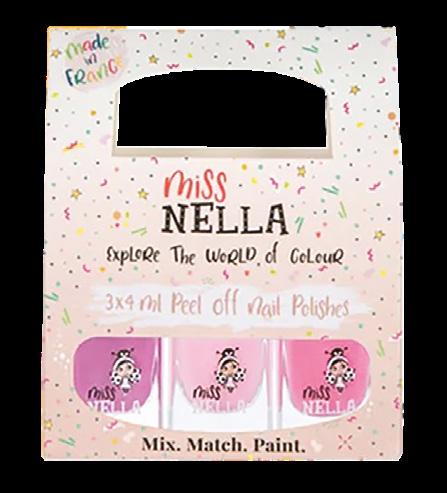
‘Can I paint your nails please….?’. Do these words secretly fill any other parents with dread? Well ‘Miss Nella’ has come to the rescue with fantastic peel-off nail varnishes! Available in an array of vibrant rainbow colours, there really is something for everyone. With looking after your little one’s delicate skin at the brand’s core, these nail varnishes are entirely organic, non-toxic, odour and alcohol-free. The very best part, to remove them – simply peel off! These nail varnishes are thoughtfully designed to stimulate imagination and unleash creativity and individuality to the max. Their easy-to-peel nature encourages children to be truly independent, expressing themselves however they choose. Don’t let the fun stop there, why not try some of Miss Nella’s carefully designed Make up collection to complete the look. Miss Nella Nail Polish, from £5.99; Miss Nella; missnella.com



With the ever-expanding world of technology becoming even more prevalent in our children’s lives, ‘Myfirst’ has designed a smartwatch specifically for children aged 5-12. This innovative device combines the functions of a phone, GPS tracker, music player, camera, clock and fitness tracker, making it an ideal choice for children wanting to explore. With carefully designed, easy-to-use buttons made especially for tiny hands and both right- and left-hand users, children can enjoy unlimited calls, video calls and app messaging capabilities, with current eSIM service covering 85 countries worldwide. What’s more, the Myfirst Fone R2 has been designed to withstand the life of our active little ones, so no need to worry about accidental splashes or spills. Boasting water resistance of up to 3 metres for five minutes, with an additional water lock feature to eject any trapped water. This really is the smartwatch to keep our little ones active while learning about the world of technology. Myfirst Fone R2, £199.99; My First; myfirst.tech




























Dr Vanessa Saliba,
Consultant Epidemiologist,
discusses helping your children make the healthiest start through vaccination.
Wof these challenges is unavoidable, you can do your bit to protect your child from the avoidable pain and distress related to some infectious diseases. Checking your child is up to date with all their childhood immunisations is the best way to ensure they are protected from infections like measles, whooping cough, diphtheria, polio, rubella, group C meningitis and sepsis – all of which can cause serious illness and sometimes can be fatal.
nursery and school, it’s even more important to make sure your child has had all their vaccines”
The two public health interventions that have had the greatest impact on the world’s health are clean water and vaccination. In the UK, we are lucky to have a world-leading and comprehensive immunisation schedule to help give children the best start in life. Sadly, vaccine uptake levels have been falling over the past decade, with fewer children receiving a full
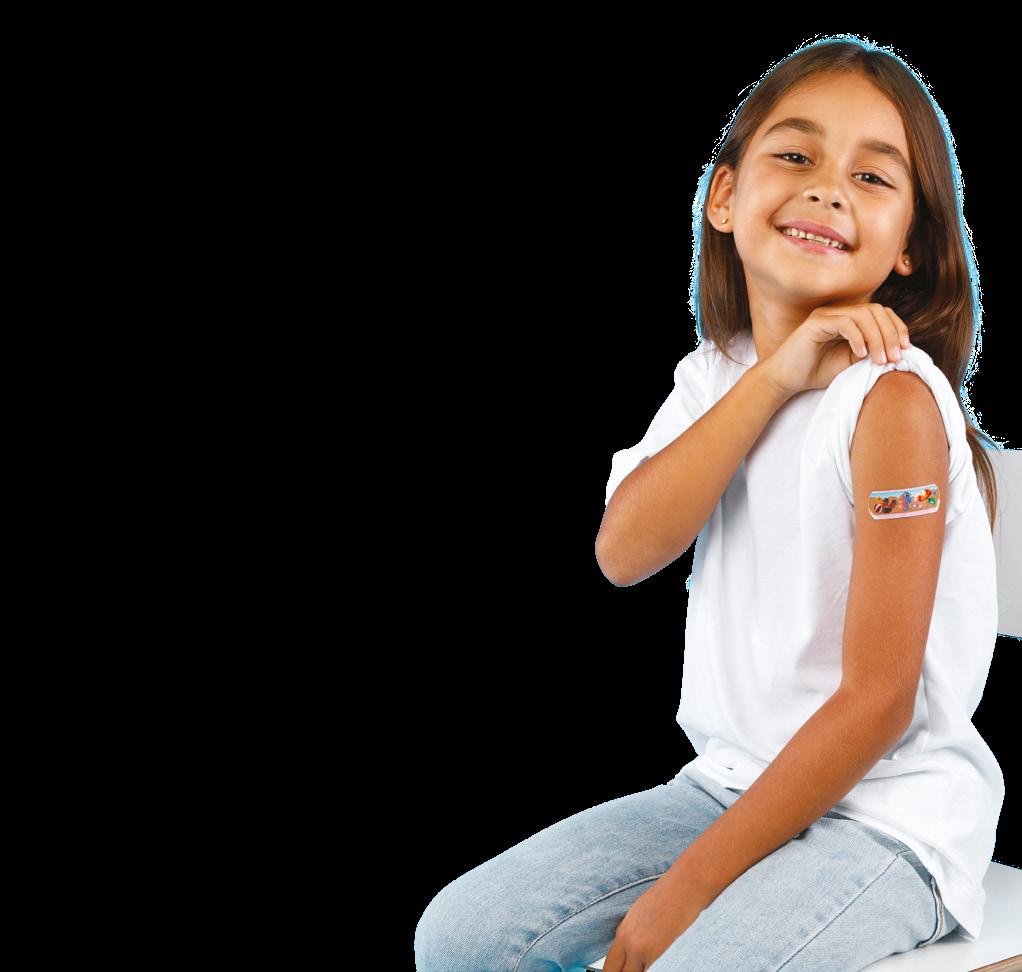

all their vaccines, as measles can spread easily in these settings, and an ill child means time off school for them, and time off work for the parent to look after them. By protecting your child through vaccination, you are giving them the healthiest start to their school years.
Your child will be offered the following vaccinations on the NHS:
At eight weeks, children are eligible for the 6-in-1 vaccine, rotavirus vaccine and MenB vaccine
At 12 weeks, children receive the second dose of the 6-in-1 and rotavirus vaccines, as well as the pneumococcal vaccine
At 16 weeks, there will be a third dose of the 6-in-1 vaccine and a second dose of the MenB vaccine
At one year old, children are offered the first dose of the MMR vaccine, alongside the Hib/MenC vaccine, a second dose of the Pneumococcal vaccine and a third dose of the MenB vaccine


eliminating measles – designating it to the history
The large measles outbreak we have seen in England this year, with more than 2,000 cases confirmed to date, should be a wake-up call as it reminds us of what happens when vaccination levels drop. As a mother and a doctor, it really upsets me to hear about children being admitted to hospital with measles – some in intensive care – when there is an excellent vaccine available free on the NHS to prevent this.
Measles can be even more serious in some vulnerable individuals, including babies in the first year of life, pregnant women and people with weakened immune systems. The only way to protect the most vulnerable is to ensure all of us and our children get their vaccines on time so that we don’t spread measles.
It’s important for vaccines to be given on time to give children the best protection, however we know that parents are juggling lots of demands on their time and so things can get missed. It’s never too late to get your children vaccinated and if you’re unsure what vaccines they have had, all you need to do is check their red book or contact your GP practice who can book an appointment to
With the return to nursery and school, it’s even more important to make sure your child has had
At three years and four months, children receive the second dose of the MMR vaccine, as well as the 4-in-1 preschool booster vaccine
At 12-13 years, the HPV vaccine is offered
At 14 years, children are offered the 3-in-1 teenage booster as well as the MenACWY vaccine protecting against types of meningitis and sepsis
If we can achieve the WHO target of 95% coverage for all childhood immunisations, we can prevent suffering and save lives. Making sure your child is protected against vaccinepreventable diseases is one of the best things you can do for your children’s health. Don’t wait for measles to be in your child’s nursery, school or community – now is the time to take action. Check their red book, speak to your GP practice and make sure your children are up-to-date with their routine immunisations.
If you have any questions about vaccines or want to find out more, please visit the NHS website: nhs.uk or contact the practice nurse at your GP practice. Always get your vaccine and health information from trusted sources, such as the NHS, health professionals or the WHO.
Dr Conall Watson, an expert on immunisations and winter illnesses, from the UK Health Security Agency (UKHSA), explains why seasonal vaccines are so important for children and pregnant mothers.
August has slipped away and it feels evermore chilly. Schools are back and nurseries are full of runny noses. As a public health consultant and dad of two, friends often ask me at this time of year about flu vaccines for children. Everyone wants to make sure that they are doing the best for their families. Pregnant friends are also keen to be reassured on vaccines recommended in pregnancy.
Winter brings germs – including flu (influenza). Why in winter? Mostly because we mix more than in school holidays, particularly indoors, and that helps germs to spread more easily. It is easy to underestimate the flu virus. My

younger child caught flu when he was a year old – too young to be eligible for the nasal spray vaccine – and was clobbered for a week, right through Christmas. He must have spent the first two to three days running a temperature, despite paracetamol, and stuck to his mum like a soggy, Velcro-pawed teddy bear. And for the rest of the week, he was exhausted. But he had it relatively mildly. Each winter, thousands of otherwise healthy children are admitted to hospital with flu and its complications, like pneumonia, or severe Strep A infections, which often follow flu. And very sadly flu is fatal in a number of cases –more often than you might think. Some things I worry about: road traffic, open water and flu. Thankfully, protecting them from flu is usually easier than gripping the banana-greased hand
of a child who thinks they are spiderman. Finding the time to get your pre-schooler vaccinated with the flu nasal spray is the best way to keep them protected against what can be a very serious illness. If you have a child who turned two or three by 31 August then they are eligible for the nasal spray vaccine at their GP. You should book an appointment with the practice nurse. For almost all children, the flu vaccine is given as a nasal spray (more like drops), rather than an injection: squirt, squirt, then home. It cuts the risk of being admitted for flu by around 70%. The vaccine can’t cause flu. And it can usually be given even if they have a runny nose at the time of the appointment. Injected flu vaccines are available, if a gelatine-free vaccine is needed for faith reasons or if the nasal spray is unsuitable for medical reasons. If you have a school-age child, look out for the consent form from their school, so they can get vaccinated in school or at a clinic run by the local school-aged immunisation team. And it is always worth checking that all of their routine immunisations are up-to-date, including MMR.
An extra vaccine has been added to the schedule for pregnant women from this year, to protect babies against RSV, a very common virus that can cause deeply unpleasant lung infections like pneumonia and bronchiolitis. For me, this is very welcome. RSV is horrible. No one enjoys seeing babies heaving their tummy muscles and ribs trying to suck in air through half-blocked airways. Paediatrician colleagues haven’t exactly put their feet up, but they are looking forward to seeing many, many, fewer sick babies this winter. But I do understand why people have concerns about getting vaccinated in pregnancy. Safety is superimportant for vaccines, especially when used in pregnancy. The vaccine has been studied in thousands of pregnant women in clinical trials and given to more than 100,000 mumsto-be in the USA as part of their national programme. Studies by US obstetricians and immunisation specialists have shown a good

“The immune system is naturally weakened to ensure your pregnancy is successful”

safety profile. The UK medicines regulator and the JCVI committee of vaccine experts have also closely scrutinised the safety data before recommending it from week 28 of pregnancy. I’m personally very happy to recommend this vaccine. After vaccination you might get a headache, achy muscles or some soreness and redness where the injection was given – well worth it (he says) for the protection baby will get. Having it at or soon after 28 weeks gives protection even if baby then arrives earlier than planned!
The RSV vaccine uses the same approach as we use to protect babies from whooping cough. Pregnant women have been safely
vaccinated against whooping cough in the UK for over a decade and it makes a real difference to keeping baby safe against a very nasty illness. The whooping cough vaccine boosts the pregnant woman’s antibody levels high enough for them to pass across the placenta to the baby to protect them after they are born. It is usually ideally given a bit earlier in pregnancy than RSV, around the time of the 20-week scan, although both can be given together if the whooping cough vaccine hasn’t been given by 28 weeks.
“Each winter, thousands of otherwise healthy children are admitted to hospital with flu”
No doubt you will have seen in the news this year that whooping cough has been surging after coronavirus control measures held back its spread. The “100-day cough” may be making headlines, but the real story is the risk to babies. Sadly, there have been ten deaths in babies under three months since the resurgence began last November. The whooping cough vaccine is lifesaving, giving over 90% protection.
There are two further vaccines routinely given in pregnancy if you are pregnant at the time of the year when these are offered – flu and COVID-19. These protect baby, but mostly by protecting you! Pregnancy puts lots of extra demands on your body, including your lungs and heart, as you meet all of your growing baby’s needs. The immune system is naturally weakened to ensure your pregnancy is successful. So, you are more likely to be hospitalised by either of these viruses during pregnancy than when you are not pregnant. This can include intensive care, and things can end quite badly for mum, baby, or both. So do please take up these vaccines too. Both vaccines have been extensively monitored by the medicines regulator and have a good safety record in pregnancy. They can be given at any point in pregnancy, and alongside the other vaccines.
Time spent getting vaccinated is time well spent to keep yourself and family safe.
You can find more information from the NHS website: nhs.uk and GOV.UK website: gov. uk, as well as your trusted health professional.
Stock up before they block up. Stock up before they block up. Stock up before they block up.
TNo.1 heNo. 1 selling decongestantoil * No.1

Get ready for the winter rush with the Olbas range of easy breathing products with soothing menthol vapours. Olbas will be supported by a nationwide TV campaign, a digital marketing campaign as well as PR activity to drive media coverage throughout the peak winter season. *Circana Cold & Flu Decongestants, Volume Sales, 52 w/e 8 June 24, All Outlets

it, it can be tough to experience the sense of separation that comes from seeing your child head off to ‘big school’ and for your child, this experience can be overwhelming.
After growing up in a pandemic, the Ofsted research also reported that, “many children were still lacking confidence in social settings”. One of the strongest ways to help improve confidence in children is to begin interacting with the performing arts. Organisations such as Stagecoach pride themselves on building confidence in children through the performing arts. Learning performance skills helps young children discover how to communicate with their peers as they work together using their imagination and empathy to put themselves in the mindsets of characters. They also build their vocabulary as they learn new songs and lines for their performance pieces.

A further concern for young children is finding opportunities to exercise and reducing screen time. Activities such as dancing can support their motor skills and help them discover a form of exercise that’s fun and appropriate for their age group.
Stepping back out onto the stage of life after the pandemic was a strange experience for all of us. After two years of lockdowns, a lot of anxiety and likely developing a new home-based hobby, we were finally heading back into a world we knew. But, each one of was a little bit different than who we were before.
For our youngest generation, the pandemic was especially impactful. We’ve all heard in the news about the huge effect Covid had on education but what about pre-school children or those born during the pandemic?
An Ofsted review of the effects of the pandemic on summer term 2022 reported that, “children’s communication and language development continued to be affected. An increased number of children have been referred for additional support, although children are having to wait months for this specialist help.”[1] This has led many parents to look to extracurricular activities to provide additional opportunities for language development and social interaction as their children step into the mainstream classroom for
the first time.
Stagecoach Performing Arts offers classes in singing, dancing and acting from ages four and up (with select schools starting classes at age two).
This means children can explore roleplay, storytelling and working with their peers as they reach school age. This is a huge time of change for both children and their parents.
After growing up in a pandemic, the Ofsted research also reported that, “many children were still lacking confidence in social settings”.
The Department of Education also reports that, “creative expression supports children’s emotional wellbeing and reduces anxiety.”[2] It helps them communicate, show their interests and explore a sense of self. Children have an understanding of performance from an early age and some relish the opportunity to show off what they’ve learned. This can be a way to gain positive attention and validation from those around them.

Whether your child was born during the pandemic or lived their earliest years through
The performing arts hold many benefits for young children in a postpandemic world. If you’d like to explore how the performing arts can build your child’s confidence, communication skills and creative expression, you can find your local Stagecoach Performing Arts school by searching your postcode at stagecoach.co.uk
[1] https://www.gov.uk/government/publications/ education-recovery-in-early-years-providerssummer-2022/education-recovery-in-early-years-providerssummer-2022 [2] https://help-for-early-years-providers.education.gov.uk/ expressive-arts-and-design/communicating-through-arts



While it may be cold outside, autumn is the perfect time of year to put on some warm clothing and get outside to collect natural materials for some fun autumn craft activities.
In the age of digital devices and far too much screen time, it’s becoming increasingly important to encourage children to engage with nature. Outdoor crafts not only provide a fun and educational experience, but also help develop a child’s creativity, fine motor skills and appreciation for the world around them. They provide endless opportunities for learning, play and bonding with your children. So, put away the screens, step outside, and discover the joy and wonder of crafting in nature together.

AUTUMN LEAF COLLAGE
Materials needed:
Collection of leaves, flowers, twigs and pebbles Glue Cardboard or heavy paper

Instructions:
Take your children on a nature walk to collect various sizes of autumn leaves, flowers, twigs and pebbles. Once back, let them arrange their findings on a piece of cardboard or heavy paper, creating beautiful and unique collages. This activity is perfect for sparking conversations about different plants and their habitats, as well as the changing seasons.
Materials needed:
Smooth rocks Acrylic paint
Paintbrushes Sealant spray

Instructions:
Find some smooth rocks during a family walk or in your garden. After cleaning the rocks, let your children paint them with different designs –from ladybirds to abstract patterns. Once the paint dries, apply a coat of sealant to make their artwork weatherproof. These painted rocks can decorate your garden or be given as thoughtful gifts.

Materials needed:
Pine cones Peanut butter (ensure no allergies) Birdseed String
Instructions:
Spread peanut butter over the pine cones, then roll them in birdseed until completely covered. Thread a piece of string through the top of the pine cone and hang it on a tree branch. Children will love watching birds visit their handmade feeders, and it’s a wonderful way to teach them about local wildlife preparing for winter.

Materials needed:
Acorns String
Small drill (used by an adult)
Paint and brushes (optional)
Instructions:
Collect acorns and have an adult drill small holes through the tops. Children can paint the acorns in vibrant colours if they wish. Thread the acorns onto a piece of string to create necklaces. This simple craft combines nature with creativity, resulting in charming autumn jewellery.



Materials needed:
Old pots, pans and kitchen utensils Water
Soil Old table or wooden crates
Instructions:
Set up a mud kitchen in a corner of your garden using old pots, pans and kitchen utensils. Provide water and soil for mixing. Children can pretend to cook with natural ingredients, fostering imaginative play and sensory exploration. This messy play activity is great for tactile learning and creativity.

Materials needed:
List of items to find (specific leaves, flowers, rocks, etc.) Basket or bag
Instructions:
Set up a list of natural items for your children to find in your garden or local park. Once they’ve collected everything, use the items to create various crafts such as collages, leaf rubbings or nature-inspired decorations. This activity not only encourages exploration, but also provides a treasure trove of materials for future crafts.

Materials needed:
Small pumpkins or gourds
Acrylic paint Paintbrushes Sealant spray
Instructions:
Find small pumpkins at a local farm or supermarket. After cleaning the surfaces, let your children paint them with different designs – from spooky faces to intricate patterns. Once the paint dries, apply a coat of sealant to make their artwork last. These painted pumpkins can decorate your home or garden and add a festive touch to your autumn décor.
1 Preparation: ensure you have all necessary materials ready before starting the activity.
2 Weather considerations: choose days with suitable weather conditions. Mild and dry days are ideal for outdoor crafting.
3 Clothing: dress your children in comfortable, old clothing that can get dirty.

4
Safety: supervise children, especially when using tools like scissors or hot glue guns.
5 Clean-up: encourage children to help with clean-up to instil a sense of responsibility.



























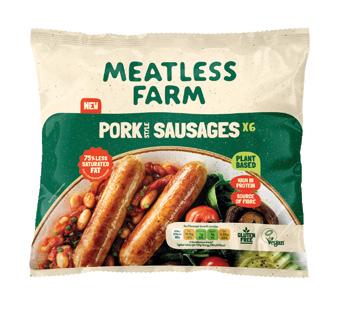


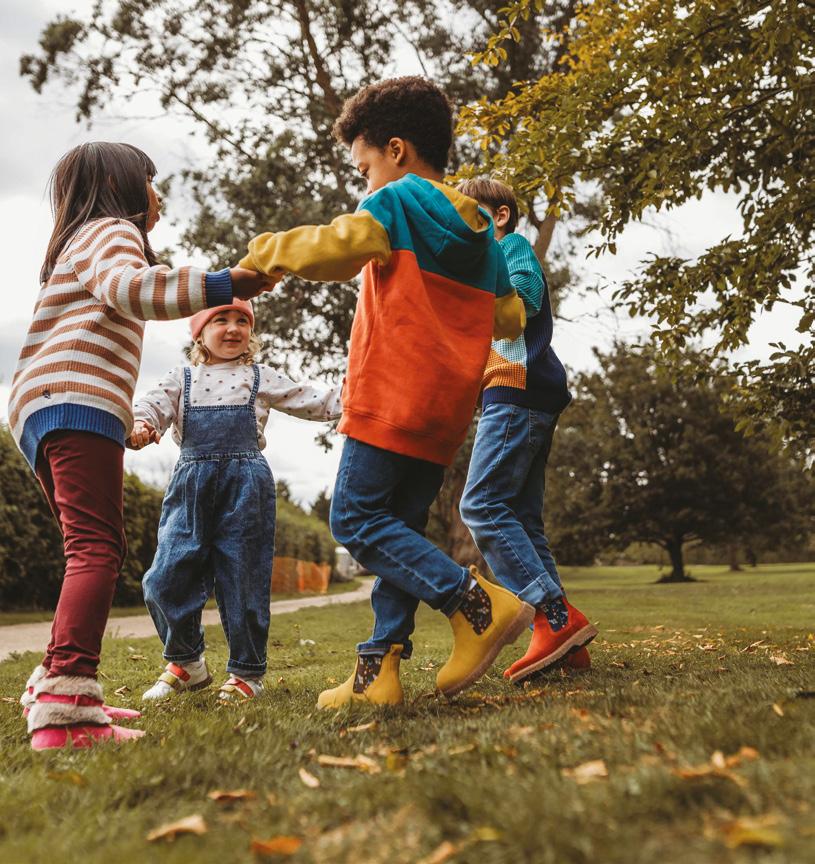



As the warm hues of autumn transform the landscape, lets get ready for a cosy season ahead. Think comfy knits, classic cords and dashing dungarees!






When it rains, look for rainbows! Brighten your day with wet weather gear that’s guaranteed to stand out. Say hello to our bright and bold collection sure to be a rainbow in someone’s cloud.






and
and


Talking about your death, or the death of your loved ones, can be hard. But when you’re a parent, it can be so important to have plans in place to help mitigate the impact that it could have on your children, partner and loved ones. Making the decision to take out a policy can help provide crucial support to your family during the hardest days of their lives.
Because we know how critical this support can be, Polly’s ambition is to provide life insurance to Mums, so you can have the peace of mind and reassurance that the people you love the most are financially covered. Because as much as we hope you’ll never need it, we truly believe you won’t regret it if you find yourself in that situation.
* https://www.childbereavementuk.org/death-bereavement-statistics Terms and Conditions


But according to statistics from Child Bereavement UK*, a child loses a parent they rely on financially every 20 minutes. That’s approximately 26,900 parents of dependents each year.
You might think you’ll never see the money, but if you’re diagnosed with a terminal illness, and given less than 12 months to live, you’ll receive a full payout of your policy value so you can make lasting memories with your family.
Prices for £100k of cover start from just £5 per month, and £6.07 for £250k sum assured. And because we understand that everyone’s different, we often don’t charge extra for disclosures that other insurers will, such as mental health conditions, certain careers, or minor medical conditions like asthma. So, if you’ve been turned down before, we might be able to help.

“I have been on my own healing journey which has taught me a lot”
‘I felt like I had a calling and wanted to
Mother of two, TV personality and presenter, Ferne McCann speaks to Becky Todd on all things parenting, including juggling family life with a career, mental health and her latest business venture.
The journey to parenthood is undoubtedly an overwhelming one, especially if you are expanding your family, while launching a new business, with countless plates that still need to be kept spinning in the background. Ferne, proud mum to Sunday (6) and Finty (1) gives us a glimpse into her life as a mother of two and the challenges of motherhood she navigates daily. Ferne discusses the importance of self-care and how this supports her newest business venture with her fiancé Lorri Haines. We find out why she is so passionate about prioritising well-being (especially for parents!) and tells us all about what it’s really like balancing a busy career with motherhood.
“I have learnt the tools to help me feel balanced and calm”
Congratulations on becoming a mum of two! How are you finding the transition from one to two children – any top tips for our families?
Q:
A:
I actually really enjoyed the transition, I think I skipped the whole two under two stresses as Sunday is at school. I get the daytime with Finty and then we get family time together after school with both the girls.
As someone with an extremely busy work life, how do you manage to juggle work with two children?
A: Q:
As I have always said, it really does take a village and I have built a whole village around our little family. I have an amazing work team around me and we also have a huge support network.


“Living my life in the public eye has its ups and downs”

You have always been incredibly open and share so much of your life in the public eye – do you think this has affected your mental health in any way?
I think that is a really difficult question to answer because it’s like anything in life – you could question what effect it has had on your mental health. When I was younger all I ever wanted to do was entertain and be famous and I have always said, “Be careful what you wish for”, as it may not be all you fantasized about. Of course, living my life in the public eye has its ups and downs, but when it comes to my mental health, I have learnt the tools to help me feel balanced and calm.

Our house is a very busy household and there is always someone around to hold the baby or help with the girls if I need to jump on a call or film something.
Last year, you launched ‘Shoorah’, a mental health and well-being app designed to help users support their mental health. Why did you choose to do something in the mental health field?
I felt like I had a calling and wanted to start living out my true purpose. I have been on my own healing journey which has taught me a lot and some of those lessons I felt I wanted to share with others. A: Q:
How do you think busy parents might be able to benefit from the ‘ Shoorah’ app?
It is a one-stop-shop for all things mental health, everything you need in one place, from journaling and affirmations to sleep stories and more. It’s all there on your phone at the click of a button meaning busy parents can access it anywhere, anytime.
How do you and your partner Lorri still find the time to spend quality time with your children, as well as each other, while both being working parents?
I like to be a present mother and I feel it’s a privilege to be able to do this. I want to be on the school run and be at every school event and I feel like I have worked hard to create a lifestyle that allows me to do that. Work is fitted in around family life as much as possible. Lorri and I try to keep weekends free for family time together!
A: A: A: A: Q: Q: Q: Q:
What are your favourite activities you enjoy doing as a family?
Movie night, cooking a fakeaway – smash burgers or tacos – going out to a nice restaurant with the kids or going for a nice walk in nature.
“I want to be on the school run and be at every school event and I feel like I have worked hard to create a lifestyle that allows me to do that”


QUICKFIRE Q&A

“I have always said, it really does take a village and I have built a whole village around our little family”
What’s your best parenting hack?
Save any questions until bath and bedtime as that’s when I get the most out of Sunday.
What’s something you wish you knew before becoming a parent?
That you say goodbye to lie-ins! How would Sunday describe you in three words?
Resilient, funny and majestic!
What’s your idea of a perfect date night?
This is really boring, but I love getting glammed up as it doesn’t happen very often these days! Going to an unbelievable restaurant with good drinks, good vibes and amazing service. It takes me back to when Lorri and I first met.

More information about Ferne McCann’s latest venture, health and well-being app ‘Shoorah’, can be found at http://shoorah.io/#
Becky Todd is a freelance writer and mum to two girls based in Kent. With more than 10 years of experience working as a primary school teacher, she is committed and most excited about sharing her own experiences of parenthood, lifestyle and everything in between.



































































































































































DEPARTING FRIDAY 20TH & SATURDAY 21ST DECEMBER 2024
Embark on an enchanting adventure with Santa and his helpers as they merrily make their way through festively adorned vintage carriages during this 1 hour and 30 minutes magical steam train journey from London Victoria.


































YOUR TICKET ON THE SANTA STEAM EXPRESS INCLUDES:
Children will be served a sweet treat and drink before meeting Santa for their christmas gift. Adults will be served a mince pie and a cup of mulled wine, tea or co ee.

FARES FROM £55






















































We understand that every family has different tastes and nutritional needs at breakfast. As the UK’s No.1 Multigrain brand*, Cheerios® offers both Multigrain and Honey cereal variants to provide delicious flavour options with nutrients to start your day, bringing together taste and nutrition^ for families across the UK.



As the UK families’ favourite Multigrain Cereal Brand*, Cheerios® is crafted with a blend of three wholesome grains – oats, wheat, and barley, bringing a high-fibre cereal that is well loved and widely enjoyed by households across the UK. Every 30g serving of Cheerios® Multigrain Cereal offers 2.9g of fibre towards your recommended daily fibre intake**, helping you to get your daily fibre needs. With each bite, you are enjoying a cereal that is a source of 7 vitamins, iron and calcium – including vitamin B6 and iron that support immunity and help give you energy for the day^
With Cheerios® you can easily enjoy your morning with the goodness^ from nutrients and the satisfaction of a delicious, crunchy cereal.

We also offer Cheerios® Honey Cereal, which combines multigrain with a delightful taste of real honey for a delicious twist. Same as our Multigrain variant, the crunchy Cheerios® Honey Cereal is free from artificial colours and flavours, making it a fantastic option for those who crave a touch of flavour and crunchiness in their morning bowl.
So why not make Cheerios® Multigrain or Honey Cereal a part of your family’s balanced breakfast? With their delicious taste, nutritional attributes, and the trusted quality of Cheerios, they are sure to be a hit with everyone at the table.





Make this Christmas even more special with a gift guide guaranteed not to disappoint. Whether you’re looking for something to spark imaginative play, encourage STEM learning or simply bring a big smile to your child’s face on Christmas morning, the experts at the Good Play Guide have something special for everyone.
As the festive season approaches, we know that finding the perfect gift for the little ones can be both a joy and a challenge. That’s why the Good Play Guide team have done the hard work for you, selecting the best toys and games that not only promise hours of fun, but also support children’s development in meaningful ways – each item has been rigorously tested by their team of child development experts and enthusiastic young testers to ensure they deliver on fun, skill development and ease of use.
Let this guide be your go-to resource for thoughtful and exciting gifts that will be cherished well beyond Christmas. Happy gifting and Merry Christmas from the Good Play Guide!
OUR LITTLE WORLD – ACTIVITY WALKER
AGE: 6+ MONTHS
PRICE: £60
This beautiful walker not only encourages younger children to pull themselves up and stay on their feet, it also contains a character peg maze, shape sorter, peg track and flip blocks with printed numbers and letters! Our testers enjoyed all of its features, and pushing it around helped them to develop their core strength, leg muscles, and balance. Available from: https://tinyurl. com/4ebw4zrt




BIBS WOBBLY TOWER
AGE: 6+ MONTHS
PRICE: £20.95
The Wobbly Tower is a multifunctional stacking toy with endless possibilities! Imprints and small holes of different sizes make it great for sand and water play. Rattling sounds and different textures stimulate the senses and it is made of safe, food-grade material making it an ideal snack bowl. Our young testers loved this toy. Available from: https:// tinyurl.com/yeu7ddsw
AGE: FROM BIRTH PRICE: £10 PER PIECE
The Cotterpillar is a wonderful personalised gift that adds a special touch to a nursery or playroom. Stylish and practical, our testers liked that this beautiful cushion reduces the chance of a baby hurting themselves on the cot rail, and is soft on mum and dad’s tummy when leaning over to put baby to bed. Available from: https://tinyurl. com/2k3m4wfv
NOGGINSTIK DEVELOPMENTAL LIGHT-UP RATTLE
AGE: FROM BIRTH PRICE: £24.99
The multi-award winning NogginStik™ is more than just a rattle, it is a multi-activity toy designed to encourage baby’s early milestones. The Nogginstik’s colour changing face immediately caught the interest of our young testers, the textured handle is a great sensory addition, and the size and shape of the toy is perfect for little hands. Available from: https://tinyurl.com/5n8ahf76
PAW PATROL RYDER’S ALPHABET TABLET
AGE: 3+ YEARS
PRICE: £20
This interactive first tablet encourages children to learn their alphabet whilst having fun with Ryder and the Pups! Colourful and interactive, the tablet helps children with letter recognition and phonic learning. Our testers enjoyed answering questions from the much-loved character making it the ideal gift for fun and learning. Available from: https://tinyurl.com/ yckajrkt

AGE: ALL AGES
PRICE: £14.99
Warmies® are microwavable soft toys, gently scented with relaxing lavender for hours of soothing warmth and comfort. Luxuriously soft and weighted, they make perfect bedtime companions for all ages - especially on a cold winter’s night! Our testers loved the cute designs and weight of the Warmies, and the therapeutic benefits of the heat and calming lavender, making it an ideal gift. Available from: https://tinyurl.com/2pv48zxe


AGE: 18+ MONTHS
PRICE: £18
The Giant Activity Aqua Mat offers endless mess-free fun. Simply fill the pen with water to reveal rainbow colours and hidden animals! Encouraging creativity, fine motor skills and hand-eye coordination, our young testers loved the surprise of discovering animals and colours and filling the space with different shapes and patterns. Available from: https://tinyurl.com/yhm2exa4
WHO’S HIDING? PUZZLE – JUNGLE JAMBOREE
AGE: 2+ YEARS
PRICE: £12.95


ittle ones will love to solve this puzzle that’s full of surprises! First, complete the colourful jungle jigsaw with 20 large pieces, and then lift the 10 flaps to discover who is hiding underneath each one. Parents liked that it was made from thick wipe-clean board and the children had lots of fun guessing which animals were hiding under the flaps. Available from: https://tinyurl. com/5ewjwc98
MAGNA-TILES® CLEAR COLOURS 32-PIECE SET
AGE: 3+ YEARS PRICE: £34.99
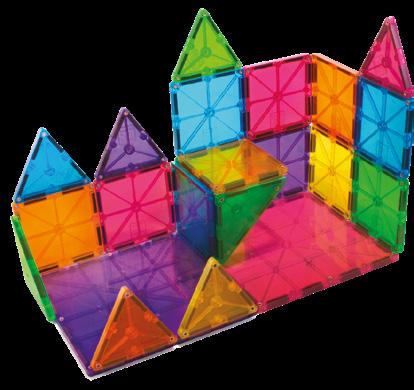
STEM-approved, the MAGNA-TILES® Clear Colours 32-Piece Set sparks hours of unstructured, free play! There is no right or wrong way to use them – instead, this vital screenfree playtime encourages children to explore their imagination while helping them develop important skills. Our testers loved working together with their peers to design and create different structures, and using their imagination to act out different storylines, all the while developing their understanding of magnets, geometric shapes and construction.. Available from: https:// tinyurl.com/ypfwb5b7


It all star ted in 1936, in a small village in the West of France, where Gabriel Pasquier, the village baker, created his renowned brioche and pâtisserie. The rest, as they say, is history...













After many years of baking our delicious brioche, one day we had the idea to create a scrumptious brioche for children that would be great to enjoy wherever they go.
A little while later, the PITCH we know and love was born: a yummy, lled brioche roll that is perfect for lunchboxes, for a breaktime snack or to keep your little ones occupied on long car journeys (as they are mess free!).










AGE: 3+ YEARS
PRICE: £99.99
Yoto Player is a screen-free speaker designed for children that brings the best stories, music, activities, podcasts and radio together. Super easy to use, children simply pop in a card to play the audio. Our parents appreciated how effective it was in building a relaxing bedtime routine with the literacy benefits that children would get from reading a book. Available from: https://tinyurl.com/4x4nfve9
MOOD BEARS
BEARS
AGE: 3+ YEARS
£22.99

Mood Bears are soft, cuddly toys designed to help children express and understand emotions. Each of the eight bears represents a different feeling, aiding in emotional communication and imaginative play. Our experts found them to be a fantastic tool to support children’s mental health and wellbeing and support personal, social and emotional development. Available from: https://tinyurl.com/4kmjjua5

AGE: 4+ YEARS
PRICE: £39.99
Orboot Earth is an ARpowered interactive globe that encourages independent exploration and learning. By scanning the globe, children can explore different animals, maps, cultures, cuisines, landmarks and inventions, while doing quizzes and fun story-based challenges. The globe was very popular with our testers, and a great way to get children interested in our wonderful and diverse planet. Available from: https://tinyurl. com/2cfzjvn6

AGE: 3+ YEARS PRICE: £3.99
Fun to Learn magazines are an excellent Christmas gift! Perfect for Christmas Eve boxes and Christmas Day, this lowcost gift will keep children entertained while you cook the Christmas dinner, or spend quality time together completing the fun activities inside. Available from: https:// tinyurl.com/325cfvef


AGE: 3+ YEARS PRICE: £54.99
Get ready to race as Bam or Redbird in this exciting new Micro Scalextric set featuring Batwheels from Warner Bros! Specifically designed for children, this set provides all the fun and excitement of full-sized slot car racing in a smaller, 1:64 scale. Our testers were overcome with excitement racing the cars against each other and enjoyed using their imagination to create a story around the racing. This is the perfect set to entertain the children (and adults!) this Christmas. Available from: https:// tinyurl.com/ycy36nym
AGE: 7+ YEARS
PRICE: £16.77
Rubik’s Gridlock is a STEM-accredited puzzle to celebrate the Rubik’s Cube’s 50th Anniversary! This new twist on the classic puzzle challenges flexible thinking and problem-solving skills. Our testers enjoyed the varied difficulty levels and engaging puzzle cards, making it a perfect brain-boosting game for solo or partnered play. Available from: https://tinyurl.com/yj2dv87a

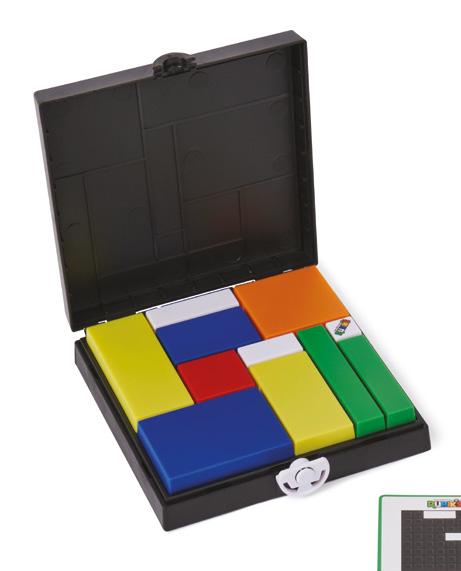
AGE: 8+ YEARS
PRICE: £25

Unlock the mystery of Shashibo, the shape-shifting box. Just one mysterious Shashibo can transform into over 70 shapes - connect multiple cubes together for endless creativity! Made from 100% recycled plastic, Shashibo cubes enhance trial and error learning and develop visual and sensory skills. A hit among our testers, these cubes offer engaging, independent play. Available from: https://
AGE: 8+ YEARS
PRICE: £18.99
The National Geographic Multicolor LED Night Light Craft Kit lets kids craft their own space-themed night light with over 1,000 gems in seven vibrant colours. Testers loved creating and displaying their unique designs, turning their rooms into mesmerising space observatories. Ideal for solo or group activities, it combines artistic expression with hands-on learning. Available https://tinyurl.com/yd59nhbv

HARRY POTTER PUZZLE, 540PC HOGWARTS 3D
AGE: 10+ YEARS
PRICE: £79.99
AGE: 7+ YEARS
PRICE: £22
The Kanoodle® Ultimate Puzzle Game will challenge your child’s mind with 500 brain-bending 2D and 3D puzzles. Set up the puzzle, start the timer, and solve the puzzle before time runs out to become the Kanoodle® Ultimate Champion! Our testers loved this game, and the travel-friendly design will be perfect for visits to friends and family over the festive period. Available from: https://tinyurl.com/555zs4j4

Children can immerse themselves in the World of Wizardry as they piece together this impressive building in 3D! Perfect for Harry Potter fans, this puzzle challenges children’s problem-solving and logical thinking skills to build a beautiful Hogwarts Castle. The model looks very realistic when finished, which provided our testers with a wonderful sense of achievement. Available from: https:// tinyurl.com/ycx5a37x

The Good Play Guide (goodplayguide. com) is your one-stop for all things ‘play’. Find the perfect products for your children with our independent experts’ reviews, get advice on how to help your children thrive and see how play can benefit the whole family.



‘A lot of people don’t know how to explain to their children
Devoted animal welfare advocate Kate Lawler, speaks to Becky Todd about why she’s proud to be supporting the Blue Cross Pet Loss Support Service, which is celebrating its 30th anniversary this year.
Grieving for a pet can be a highly distressing experience, affecting everyone differently. The Pet Loss Support Service aims to make this turbulent time more manageable, supporting you and your family members every step of the way through whatever you might be feeling.
“Get your child to remember their pet in a really positive way”
The Pet Loss Service offers a wide range of support, including a free and confidential helpline, webchat email and Facebook group, as well as practical strategies to help support you or your family through the grieving process. The services
core mission is to ensure as many people as possible are supported with compassion and understanding so that no one goes through the upsetting time of pet loss alone. We find out more from Kate Lawler about why she is supporting the service.
It’s clear to see your dogs are like family members to you, would you be able to tell us a bit about Baxter and Shirley?
Baxter, I’ve had since he was a puppy and he’s a Border Terrier. He’s going to be 14 in November and he is a classic Border Terrier – he doesn’t come running to the door and greet me when I get in, but is still very excited to see me. He’s recently been really poorly with pancreatitis, but he’s on the mend. He’s just a really amazing dog! I’ve got another dog Shirley and she is coming up to eight. She was living in a foster home when I rescued her; she just jumped into my lap and was like, “Please rescue me!”. She’s very scruffy and speedy and just amazing. She just





enduring the pain of losing a pet. I think that more people need to know about the Pet Loss Support Service because of how valuable it can be for anyone, especially for helping children. A lot of people don’t know how to explain to their children about the loss of a pet. It can be really upsetting for the whole family and I just wanted to raise awareness about the service.
“The first thing is not to underestimate your child’s feelings”

As someone who has invested a lot of time in the welfare of animals with a number of different charities, what was it about the Blue Cross service that made you want to get involved?
Q:
You recently visited the Victoria Animal Hospital and met with the head of Pet Loss Support, Diane James. Would you be able to tell us a bit about your visit?
A:
The animal hospital was incredible. It’s there to support people who financially can’t afford veterinary bills or who need support in paying them. A beautiful hospital with lovely staff. It was really wonderful to see firsthand the work they do in helping those less fortunate who really love their animals and who struggle to pay vet bills, which are obviously really expensive. It was great to talk to Diane because she told me all about the Pet Loss Support Service and how it’s helped more than 20,000 people alone. Plus, everyone who works there is actually a volunteer who has had their own pets.
Growing up as a child, did you have any pets and was loss of a pet something you had to go through?
Q: Q: A: A:
Well, I’ve always admired the work that the Blue Cross does, but I also never knew about their Pet Loss Support Service. One of the hardest things that I can imagine happening is losing Baxter or Shirley and I know it’s inevitable. I know I’m going to really struggle when it does happen, because I know how it felt recently when I thought Baxter wasn’t going to make it through pancreatitis. Not everybody has somebody to turn to when they’re
We had loads of goldfish because my Dad decided to buy a big goldfish tank in the 80s. Then we had a budgie called Yogi and I always remember Yogi flying around our living room which was hilarious. My sister and I got pet rabbits for our 12th birthday called Salt and Pepper. We begged our parents for a dog and when I was 16 we finally got one. He was a West Highland Terrier, who actually lived until he was 20. My parents had to put him down; he probably would have lived for longer, but they knew it was the best decision. So we only experienced our family dog dying when we were all
adults and that’s something my mum has still never got over because Charlie ended up being their dog. It was that classic thing of kids begging their parents for a dog and then telling us that we had to walk him every day and then we’d get bored of walking him after a month and then he just became their dog. They took him everywhere with them. I just remember Charlie being such a big part of our lives. We all loved him so much.
What advice would you give to parents to help prepare their children for losing a pet?
The first thing is not to underestimate your child’s feelings, because I think talking is really important. Just like adults, we forget how important talking is. I know that there are going to be times when I’ll be crying in front of my daughter Noa, but I think that it’s important, as you shouldn’t be afraid to show your feelings of sadness because children need to be taught about empathy. I would always say to be honest and talk about what’s happened and get your child to remember their pet in a really positive way. I remember Diane said to me, you shouldn’t lie and say that they’ve gone to live somewhere else because your child might think that it was their fault that they went elsewhere.
“A lot of people don’t know how to explain to their children about the loss of a pet”




“The Blue Cross is a charity, which is 100% funded by voluntary contributions”

She also said not to say they’ve been put to sleep, because otherwise children might then fear themselves going to sleep and not waking up. There are loads of other helpful tips on the Blue Cross Website that are really valuable in supporting children. If you are struggling, you can talk to the Blue Cross on the phone, via a web chat online, there’s something there for everyone, it’s an amazing service that more people need to find out about.
Q: A:
How will you go about broaching the subject of pet loss with your daughter when the time comes?
I mean this is a tough question because I’m already preparing Noa. One thing the Blue Cross suggest doing, which I’ve already started doing with Noa, is creating a little memory box for them
both. Baxter has his smartest bow tie and he’s really obsessed with one of Noa’s Peppa Pig toys. Shirley’s obsessed with one of Noa’s toys too – a little lion that we called Lenny that she’s ripped both eyes out of! So we have a Baxter and Shirley box. It’s a really lovely way to remember your pet in a loving way because you can put things like photos of you all in there, their favourite blanket and lots of nice things to remember your pet by.
If people wanted to join you in supporting the Blue Cross Pet Loss Support Service, are there ways they could get involved?
Q: A: Q: A:
The Blue Cross is a charity, which is 100% funded by voluntary contributions, so I know donations are always incredibly appreciated. These lovely people are giving up their time and are always looking for more volunteers, there are so many different ways you can volunteer with them which are all on The Blue Cross website.
If Baxter & Shirley could talk, how do you think they’d describe you?
Oh my goodness! I reckon Baxter would probably say that she’s a bit too in your face and Shirley would be my biggest cheerleader because she’s obsessed with me.

The Blue Cross is dedicated to improving animal welfare and quality of life for all vulnerable pets. More information about the Blue Cross Pet Loss Support scheme including support lines, resources as well as volunteering opportunities can be found at bluecross.org.uk/petbereavement-and-pet-loss
Saiqa (Capstone Foster Care foster carer), has been fostering for over fifteen years, offering many children and young people a safe and loving home.

Sarah Carter, Head of Marketing, had this to say, “Saiqa is the embodiment of family and represents what we stand for at Capstone Foster Care. We’re always needing more people like her, with big hearts and a passion to make a difference.”
“We give them love.The care, the home, the atmosphere of a loving family.”
Saiqa, along with her husband, live with their five birth children, two foster children plus a young person who is in a staying put arrangement. Fostering truly does run in the family, as Saiqa’s parents are also foster carers, and it was a family friend who set Saiqa on her fostering journey. Fostering is a family affair for her, and one filled with love, life and plenty of laughter.
Saiqa tells, “My children have always been part of the fostering journey. They’ve always been involved in everything. Welcoming the new children, going on holiday and getting involved in activities. They have ideas, and we always take them onboard – they’re part of it. We’re one big happy family!”
While there are a few essential requirements to foster, such as a spare room. For this fostering family the most important ingredient is love. As Saiqa continued, “We give them love. The care, the home, the atmosphere of a loving family.”
Saiqa wants to give vulnerable children that experience of family they may never have had before, through patience and perseverance she helps the children to open up and to thrive, often keeping in touch with them long after they’ve left care.
See more from Saiqa in her own words in Capstone Foster Care’s brand-new video on their YouTube Channel: www.youtube.com/@capstonefostercare
Could fostering be for you?
Speak with our team today on 0800 012 4004 or visit www.capstonefostercare.co.uk
Capstone Foster Care is building brighter futures for young people in foster care by establishing a network of highly engaged foster carers across England, providing access to one-ofa-kind therapeutic support and continuing to champion care experienced young people.
Plus, enter our prize draw to win a £250 high street toy voucher

re you dreaming of ways to make this Christmas the most magical yet?
Imagine transporting your family to a snowy wonderland, high above the Arctic Circle, where unforgettable memories await.
Reindeer-driven sleighs. Huskydriven sleds. Elves around every corner. Spectacular shows. Tobogganing, snowmobiles and so much more... And of course, following the glow trail in the great search for Santa. No one knows how to make Christmas more magical than Santa’s Lapland.
Two- or three-night breaks are available, so you can choose the ultimate Lapland trip which is perfectly suited to your family. Santa’s Lapland offer the complete
Lapland package, with everything you need included in the price. Choose from 16 different regional airports to depart from, and fly direct to Ivalo, from where you’ll be transported to Saariselkä, a beautifully remote spot in the far north of Finland, 200km above the Arctic Circle, where snow is guaranteed.*
The magic begins as soon as you step off the plane. Marvel at the snow-capped forests stretching as far as the eye can see, and look out for Santa’s cheeky elves getting up to mischief.
Santa’s Lapland offer a choice of accommodation options, and you can relax in your warm and comfortable surroundings, before heading out to enjoy this truly unique environment. Stay cozy in your included snow suits and boots and start exploring.
Imagine whizzing down the slopes on a toboggan, or walking through the snowy forests to search for the Northern Lights, you’ll find exceptional experiences at every turn.
And the magic doesn’t stop there… you and your family will have the chance to whizz through the wilderness on a snowmobile safari, feel the thrill of a traditional husky drawn sledge ride, and see Santa’s reindeer.
Plus, there is the chance to try out lots of fun snowy activities such as snow hocky and mini skidoos, and of course have plenty of time to just play in the snow…build a snowman, start a snowball fight, or make some snow angels.
And then it’s time to follow Santa’s magical glow trail to his cosy cabin




2024 and 2025 packages are now available to book, visit
Your families’ private meeting with Santa will leave you with memories to last a lifetime.
And when the little ones need a rest after all of the excitement, head to the traditional Finnish kotas to warm up around the crackling open fires and enjoy a glass of warm berry juice. Evening buffet meals are also included.
offers a quieter experience with a wilderness dinner, and an immersive visit to Santa’s Elves Workshop. With departures from late November, up until Christmas Eve, you can choose when to travel.
Please see website for full terms and conditions in the woods.
Santa’s Lapland offer two package options, Santa’s Magic and Santa’s Aurora. The Santa’s Aurora option includes a stay in a breathtaking location at the top of the fell, and
Santa’s Lapland have been giving families a Christmas like no other for over 19 years, so you can trust that no ones knows how to make Christmas more magical.
* In the event that we decide that there is insufficient snow, guests will have the option of amending travel dates, or cancelling and refunding.
Santa’s Lapland are offering Family First readers the chance to add extra magic to their Christmas this year, with the chance to win a toy gift voucher worth £250.
To enter, simply visit SantasLapland.com/ family-first by 30 November 2024
Debbie Scott visited the newly refurbished Butlin’s Minehead with her husband Tony and daughter Aggie for a fun-filled long weekend of nostalgia, entertainment and quality time.
Imust admit to feeling a slight unease when I told the school mums we’d decided to visit Butlin’s during our summer holiday this year, as they were all chatting about Santorini or the south of France. ‘It’s only a short break,’ I found myself saying, as if the briefness of it made it more acceptable.
Despite this, however, I was actually feeling quite positive about our trip to Britain’s best-loved holiday park. Some of my happiest childhood memories are from family holidays at Butlin’s in Minehead, the very same resort I was now visiting with my own family. Of course, most British seaside resorts have had their heyday and struggle to compete with package deals abroad and more up-market options in the UK. Butlin’s is no exception to this, but it has invested £23 million into its Minehead resort alone in the hope it will attract a wider range of families. With all this in mind, I was going with a positive attitude, determined to have a good time!

“Some of my happiest childhood memories are from family holidays at Butlin’s in Minehead”
Together with my husband Tony, and our nine-year-old daughter Aggie (neither of whom had visited Butlin’s before), we stayed for three nights in a two-bedroom chalet in the West Lakes Village. We opted for the premium dining package with all-inclusive drinks, plus early access to the shows.
We arrived a couple of hours later than planned, because it’s a bit of a mission getting to rural Somerset with the typical summer holiday traffic, but check-in was straightforward and easy. The
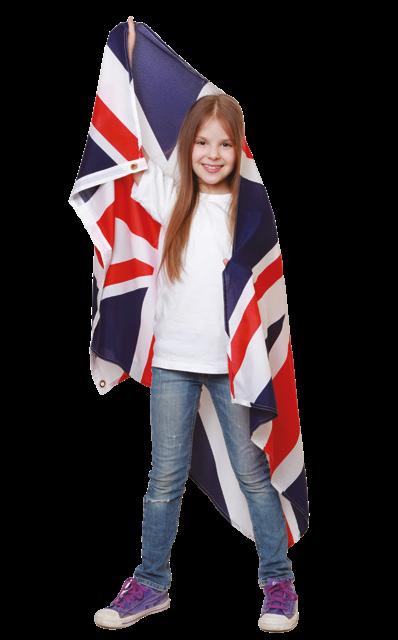

lady on the front desk was very welcoming as she gave us our keys and directed us to our chalet, where we parked within a few metres of our front door, making unloading nice and stress-free. So far, so good.
Our first impression of the chalet was that it was clean, airy, modern and well-equipped. All the little things such as storage, hooks, lighting, mirrors and plug sockets were there. The kitchen had everything we needed, and the bathroom was clean and spacious with plenty of towels. The bedrooms were a decent size, and the white bed linen was clean and crisp. The open plan kitchen-diner opened onto a patio overlooking a green and nearby lake where there were many friendly ducks who were not at all shy about waddling inside to say hello! It was lovely. These chalets were added to the resort in 2015 at a cost of £16 million and were designed in consultation with Mumsnet, so you’d expect them to be every bit as good as they are.
“The facilities are vast and there is so much to see and do that you come away feeling you’ve barely scratched the surface”
“Butlin’s is about as British as you can get when it comes to holiday resorts”
The resort is pleasantly landscaped with colourcoordinated flower beds and fairy lights lining the walkways. It genuinely feels like a nice place to be. The original chalets are still there and while they add a degree of nostalgia, they do look a little shabby and run down. I did notice they are being renovated though and I imagine this will be done tastefully in homage to the iconic resort’s past.
Butlin’s is about as British as you can get when it comes to holiday resorts and while aiming to be more contemporary, it seems to be striking a balance between appealing to all families while staying true to its roots. This is admirable, but I can’t help thinking it’s one of its biggest hurdles too. The original chalets, and those from the 1980s and ‘90s, still offer basic accommodation, and the website doesn’t try to dress this up.






“There are so many entertainment options you can’t possibly see and do everything, but those we did choose were excellent.”
towards children, but also the wider family. There are so many entertainment options you can’t possibly see and do everything, but those we did choose were excellent. The downside of all of this for me was that the dining experience was a bit like eating in a busy cafeteria, which made it less enjoyable. Obviously, you can aim to avoid the crowds by getting your table early, which makes for a slightly more pleasurable





For me, the experience could be improved with the addition of a section dedicated to healthy food. On that note, Tony commented that a gym for the adults would be a good addition to burn off all those extra calories! The other downside for me, which is also a flipside of the sheer size of the resort, was the standard of cleanliness in the pool changing rooms. The Splash Waterworld was so popular that it stands to reason the changing rooms might get a bit grubby. Not allowing outdoor shoes in the changing areas would go some way to fixing this problem, as would installing a few more showers. Saying this, our daughter thought the water park was one of the best things about Butlin’s. Her top tip to other children is to head straight to join the queue for the Master Blaster slide, which has a boat you can ride in pairs. Aggie plucked up the courage to go on this and had a complete blast. Following the fun of the water park, we decided to make the most of the entertainment. The Butlin’s app proved very handy, as it reminds you what shows you’ve booked, tells you where to find them and stores your tickets. The Early Access passes enabled us to enter venues in advance, grab a table at the front and get to the bar before the queues formed. My husband loved the all-inclusive drinks package, and I don’t think the novelty ever wore off!
Butlin’s is known for having kick-started many a career in the entertainment industry (think Stephen Mulhern, Des O’Connor, Jimmy Tarbuck and even Catherine Zeta-Jones) and it’s not hard to figure out why. The panto was laugh-out-loud funny, the circus had us on the edge of our seats, the Masked Singer was every bit as good as watching it on telly and the Festival Rocks show was packed full with brilliant music, singing and dancing.

In between watching these fantastic shows, we also benefited from some All-Action passes for activities including go-karting, pool, bowling and trampolining. There is an outdoor fun fair, which is inclusive within the price of the holiday, but there are a handful of activities that charge a small fee. It would be remiss of me not to mention the amusement arcade that sprawls out inside the Skyline Pavilion. It was huge and Aggie’s face when she entered the Pavilion was a picture.
It was all great fun, but do brace yourself for those pesky tickets that pop out of the arcade machines, which kids obsess over and exchange for plastic tat.
I must also mention how impressed we were with Butlin’s focus on inclusivity. This summer saw the opening of the SKYPARK at Minehead, which is a new playground for all ages and abilities. It features wheelchair-friendly equipment, as well as lights and music to offer a sensory experience that comes into its own after dark. Furthermore, Minehead has also opened the first Changing Places Toilet, which is part of its campaign to enable everyone to be able to use a toilet hygienically and with dignity. It includes a height-adjustable changing bench and ceiling hoist. We also observed children with special needs being given access to activities such as go-karting on an individual basis, without having to queue and with the staff making them feel at ease.
A family can go to Butlin’s and not spend much money at all. Tony and I were impressed by the extent of activities and entertainment included in the holiday. Aggie did go along to T-shirt designing which, like a few activities such as laser tag, archery and pottery
decorating, you do have to pay an additional small fee. But it was a great session, and she was thrilled to take home a T-shirt souvenir of Butlin’s that she’d designed herself.
Just when we thought it was all over and we were heading back to our chalet on the last evening, we decided to poke our heads through the door of the famous ‘Reds’ venue and what we saw was the most random sight! There in front of us was a crowded room of kids and adults alike having a brilliant time – in silence! We’d stumbled upon the silent disco and, if you can’t beat ‘em, join ‘em!
The silent disco was crazy and a great way to mark the end of our stay. At Butlin’s you’ve just got to get stuck in and enjoy yourself. The kids don’t care if the pool changing rooms aren’t pristine and they don’t mind either if there’s not a healthy food option for adults. They’re just having the time of their lives and enjoying being kids. And, to be honest, this is my memory of


you have multiple kids of various ages, then there is something for everyone. It’s a safe, fun environment that doesn’t cost the earth. It’s not Center Parcs, but nor does it pretend to be. The focus is on family entertainment rather than cycling in the woods. It’s a British institution that prides itself on offering value-formoney holidays – something that must surely be welcomed during the ongoing cost of living crisis. Millions of pounds have been invested in making the three Butlin’s resorts modern and attractive places to visit. It might have been our first experience of a holiday camp, but I’m sure it won’t be our last – I think Aggie will make sure of that, and I might just recommend it to the mums at school in September.

Butlin’s is open all year round and its forthcoming Halloween-themed ‘Spooktober’ break will be running throughout October, with prices starting from £122 for four nights in the 2024 October half term. This is based on four sharing a two-bed Silver Room on the four-night break starting 21st October that features Stephen Mulhern.

Included in the price of every family break is accommodation and access to the Splash Waterworld pool, as well as live shows and headline acts including Stephen Mulhern, The Masked Singer Live, Justin Fletcher and Peppa Pig. Next year, Butlin’s will be welcoming the Gladiators to all three resorts. There are also unlimited fairground rides, soft play and the SKYPARK playground. As mentioned, there are All Inclusive Drinks Packages, Premium Dining and Early Access upgrades available too.
Debbie Scott is one half of the Tonbridge-based communications and public affairs company Scott Communications. Tony is the other half! Debbie specialises in content creation, copyediting, editorial, proofreading and government relations while Tony leads on digital transformation and AI. Find out more at ScottComms.co.uk



Georgina Probert spent a magical weekend in the New Forest with her husband and two daughters aged 4 and 8, searching for fairies, family fun and a little bit of relaxation!
When we think about the New Forest, the first things that come to mind are free-roaming ponies and beautiful ancient woodland. For the kids, it was fairies and the Gruffalo. On our recent trip, we were lucky enough to see at least two of the above!

“The kids spent a very pleasant few hours painting their own fairy doors to take home”


We spent the weekend at Hoburne Bashley Holiday Park, which is nestled in the middle of the New Forest in New Milton, Hampshire. The park is home to a mix of static caravans and lodges to suit all budgets, with around 70 of these being privately owned and the rest available to rent for a three-night break or longer.
We stayed in a Premium two-bedroom caravan and we were so impressed by how clean and modern the accommodation was. The caravan was spacious and had everything we needed for our stay, including two bathrooms (an en-suite for the adults), a dining table, a fully-equipped kitchen with fridge/freeze, cooker, microwave and sink, free WiFi, televisions in both bedrooms and the living area, as well as chairs and a table (with sun parasol) outside – and a hot tub. The hot tub was a particular treat for the kids, who would have spent most of the holiday in there given the chance. The adults liked the fact that it was situated at the back of the building, so it wasn’t overlooked by other holidaymakers on their decking areas or walking past and there was no mad dash to get in and out without everyone seeing us in our swimmers. Parking is free across the whole site and there was space for



two cars right outside our caravan, meaning no long walks with heavy bags or moaning children.
We visited during the weekend in mid-June and while this might not be considered peak season, the park was very quiet at night (no one likes too much noise when you are trying to get the kids to sleep!) but had lots going on during the daytime – perfect for families with young kids. Hoburne Bashley also welcomes pets; it has a special dog exercise area and has dog-friendly homes available to rent.

A highlight for us was the numerous family-friendly activities – both indoor and outdoor – that are suitable for all ages to enjoy. There was so much for the kids to do that we really were spoiled for choice. In fact, as we only visited for the weekend, we spent all of our time at the park and didn’t need to venture out. If you visit for longer, there are plenty of local attractions that are a short drive from New Milton, including Highcliffe Beach that’s only a 10-minute drive away. See the box out on page 60 for more on local attractions.
There are two heated outdoor swimming pools with plenty of sun loungers and a large indoor pool that also has a hot tub, sauna and steam room – plus a shallow pool for little ones and a fantastic interactive wet play area. All of the swimming facilities are available to use at no extra cost during your stay. We did pay extra for the Wet ‘n’ Wild session for our eldest and she had a great time trying to make her way across the inflatable assault course in the indoor pool, while having buckets of water thrown at her by members of staff! Children can also book in for swimming courses and lessons.
We liked the fact that the central building houses everything you need, including reception, the indoor pool, fitness suite and beauty treatment rooms for the adults to make the most of too. There’s also a restaurant and a more casual café that serve breakfast, lunch and dinner, as well as snacks, with indoor and outdoor seating, as well as a bar and entertainment area. Plus there’s also a small indoor soft play and amusement arcade with a pool table.
Next to the pool area is a small play area, as well as outdoor multiuse games courts (think tennis, football etc), a 9-hole par 3 golf course with 18 tee positions ranging from 112 up to 242 yards and an adventure golf course.
Just around the corner from the main building is a converted lodge called the Activities Den, where you can book various craft sessions for your kids. Our girls had a go at making sand art, colouring and making bracelets, but there’s also ceramic painting, pom-pom making and sun-catcher decorating to choose from. Right next door is a brilliant Mini Sky Trek that is a specially made low ropes course for children aged 2-7 years, so they can gain their confidence balancing, swinging and leaping from each platform.
and there’s even a mailbox at the end where you can write a letter to the fairies and your message might even get answered on the Hoburne Bashley Facebook page (facebook. com/hoburnebashleyofficial ).
We also enjoyed an afternoon in the woods at the park’s forest school, which offers bushcraft and woodland activities run by the woodland manager Simon. We were so impressed with Simon’s enthusiasm for nature and knowledge about the local area. The kids spent a very pleasant few hours painting their own fairy doors to take home and making wooden wands. This was a relaxing and calming space where the children could learn about nature and enjoy crafting.
“A highlight for us was the numerous familyfriendly activities”


A highlight for our girls – who very much believe in fairies – was the woodland fairy trail. We were able to buy a bag of bird seed from reception and took this around the fairy trail to feed the birds. We were reliably informed that it is the birds that deliver letters to the fairies. The girls loved finding all of the different fairy doors around the woodland
Hoburne Bashley offers early evening entertainment for kids in the form of Tots O’Clock and Squad O’Clock. The kids loved watching the Sammy Squad perform and had great fun dancing at the disco, listening to stories and playing the interactive games.
Hoburne Bashley is open all year round giving you the ultimate flexibility for when you want to stay.

Take a trip through the history of the motor car along with a behind-thescenes look into life in the Montagu family home during its Victorian heyday. Get lost in the serene grounds or see it all from the monorail. Find out more at: beaulieu.co.uk

Get hands-on with a full schedule of fun activities and meet friendly farm animals, including donkeys, pigs, chickens and more on this working family farm. Find out more at: longdownfarm.co.uk

A fun day out with something for everyone! Enjoy more than 70 exciting rides and attractions, including the UK’s first Peppa Pig World and a journey through the Jurassic Age in the Lost Kingdom –home to the most terrifyingly lifelike moving dinosaurs. Find out more at: paultonspark.co.uk

The artillery fortress built by Henry VIII. With plenty of open space to explore and fantastic views of the Isle of Wight, Hurst Castle makes a great day out for all. Find out more at: hurstcastle.co.uk

Ride the skibobs, spin down the slopes in a Ringo or learn how to ski or snowboard at Snowtrax. All ages and abilities are welcome; you don’t even have to hit the slopes for a great day out, as there’s the Alpine Adventure Park too. Find out more at: snowtrax.eu

The perfect place for those who love the great outdoors. Try your hand at a variety of activities both on land and on the water. New Forest Activities offers canoeing, kayaking, archery, bushcraft and more, located at the scenic Hazel Copse Farm, Beaulieu. Find out more at: newforestactivities.co.uk
For more information on Hoburne Bashley or to book a holiday, visit: hoburne.com/holiday-parks/ hampshire/bashley-new-forest/





Heading abroad as a parent can be stressful. There are outfits to be planned and suitcases to be dug out of the loft, not to mention all the other holiday admin like finding passports and collecting currency.
But one thing you should be thinking about before you head for the sun is travel insurance. Because, as you know, travelling with little ones can bring up plenty of unexpected twists.
From sudden illnesses that mean cancelled plans to lost gadgets or even luggage, it can all add up – especially if you’re not covered. But don’t let any of these worries spoil your family’s escape plans.
† Under 18’s travel for free providing they have no medical
* For more information, visit postoffice.co.uk/travel-insurance/medical-assistance. **


Enjoy 10% off ** all Post Office travel insurance policies
Use the code ‘FamilyFirst10’ online or through our contact centre to get 10% off travel insurance, whether you decide to take the kids or not.

Add optional extras like gadget insurance
We all know what kids are like with gadgets… you can protect them all by adding gadget cover.^ You can also add trip disruption cover, cruise cover^ and more.

Your kids go free† on family policies
Kids need looking after even more away from home; it’s why we cover kids on the same policy as you, for free.

5 reasons to protect your family abroad with Post Office Travel Insurance
Kick back with Medical Assistance Plus* as standard Powered by Air Doctor, you’ll get 24/7 access to medical support while you’re abroad. It’s included on all our policies and means medical help is just a click away. Get
Choose from 3 levels of cover
Economy cover offers great value for cost-conscious families. And for those wanting peace of mind, our Premier protection comes with a 5-star Defaqto rating.
Picking up a bow and trying a sport that has a host of physical and mental health benefits is something that whole families can enjoy
Participation at Archery GB, the national governing body for archery in the UK, explains how the sport gives everyone the chance to get active together.
It’s one of the oldest sports in the world and probably one that many people overlook, but archery continues to hit the mark with thousands of children and families across the UK. A highly accessible and inclusive sport, archery is something that everyone, regardless of age, physical ability, disability or gender, can enjoy and potentially excel at.
With lots of clubs running beginners’ courses throughout the UK, children and
“Children and families can get active, cheer each other on and spend quality time together by picking up a bow”
families can get active, cheer each other on and spend quality time together by picking up a bow. What’s more, archery has a number of physical and mental wellbeing benefits, giving children, and adults, the chance to boost their confidence and learn skills to carry into their everyday lives.
With several disciplines to choose from, there is a type of archery for everyone and as a sport that can be adapted for different disabilities, it’s incredibly accessible. Archery provides opportunities for people to shoot in social settings where children, seniors, adults, as well as disabled and nondisabled archers, can all shoot together and participate in friendly competition.
For young children, soft archery is a great way to be introduced to the sport. Available to buy, Archery GB’s official soft archery partner, Clickers, has created Arrows soft archery kits, which provide a safe and fun introduction to the joy of archery. Using soft, suction-cup arrows, even the youngest members of the family can get involved and learn the basics.
One of the original Paralympic sports, there are many opportunities for those with physical or visual impairments to get involved. Disabled individuals can shoot standing, perching on a stool or sitting down and may use assistive devices in their archery, which clubs can help to secure. The structure and routine nature of drawing a bow, releasing to shoot and collecting your arrow can also be particularly well suited to autistic children and anyone who might struggle with team sports or has a learning


disability.
Known for its sportsmanship, the social aspect of archery and low sensory pressure environment can make all the difference for those who may feel overwhelmed by noise or crowds of unfamiliar people. With licenced archery coaches onhand to provide guidance and support, whether someone needs special assistance or wants a few tips on holding the bow, local archery clubs provide great opportunities for children and families of all abilities to have a go and reach their full potential.

Archery has many health benefits for the mind and body, both for serious archers and beginners alike. With focus and attention to detail being key to shooting an arrow and hitting the target, archery requires mind-body concentration, which can ultimately support increased mindfulness, help to reduce stress and put aside anxieties.
With conversations around mental health becoming more and more prominent, knowing how to stay calm under pressure and focus your mind is a great way for children and families to learn skills that they can apply to everyday life. In what are our often chaotic lives, archery is a great chance for the entire family to slow down, get in the zone, escape the pressures of reality and take a break from the online world. The social and friendly competition side of archery is also a great way to boost confidence and learn that resilience and determination pays off. Whether you’re a regular archer or someone trying it for the first time, when you play archery at your local club, you join a community that encourages, supports, challenges and celebrates each other.
Archery is also a great form of physical exercise and a good way to get moving. Drawing back a bow alone takes energy, strengthening muscles in the arm and back. While it may not seem like it, walking to the shooting line and then the target to collect arrows also means your step-count will increase faster than you think. What better way to get your exercise in than to shoot an arrow, socialise with likeminded

“There is a type of archery for everyone and as a sport that can be adapted for different disabilities, it’s incredibly accessible”
people and support your physical and mental health all at the same time?
“For me archery offers both physical and mental benefits – there’s no other sport quite like it. You are so focused on what your body is doing that it’s like meditation,” says Jamie Harris, member of the Archery GB Para Squad, who took up the sport when he was 14.
With more than 800 archery clubs across the country, first-time archers can discover the joys of the sport and reap many of its health benefits. Archery clubs host taster sessions,
have-a-go days and beginners’ courses all year long, and with coaches and volunteers on hand to offer advice and support, it’s the perfect environment for those wanting to try archery to get involved.
So, why not head down to your local club and try archery with your family? You’ll find a friendly, supportive and passionate community that want to help you get the most from this inclusive sport.
Making her Olympic debut at the Paris 2024 Games, 16-year-old Megan Havers first picked up a bow when she was just seven years old on a family holiday at a Haven caravan park. Megan was then given a beginners course for her eighth birthday, before buying her own bow a few months later. Megan went on to represent her county, region and then the country, only making her senior debut in March this year before being selected to represent Team GB in Paris where she finished ninth individually on her Games debut.


Find a club near you by visiting the website: startarchery.co.uk/start-my-journey/ find-a-club
The official organisation for dodgeball in the UK, British Dodgeball explains why the sport is so good to play in schools and looks at the many benefits for children.
You might think this is a bold statement, but here goes: dodgeball is the BEST sport to play during PE classes. Played using the right equipment and the correct British Dodgeball rules, dodgeball is safe, fun and boosts children’s communication skills and self-esteem due to the increased chances for success, and promotes a healthy lifestyle.
“We feel that dodgeball epitomises what sport is all about - fun, an adrenaline rush, great fitness, a great brain work-out with tactics, aids concentration and develops core social values.” – Trumacar Primary School.

Why is dodgeball better for developing physical literacy than traditional sports such as football, hockey, netball etc?

Because dodgeball is played with more than one ball! This gives children more opportunities to develop basic object control and co-ordination skills through throwing and catching.
What about the other children without a ball?
They aren’t simply stood still waiting to be passed to – they need to maintain awareness in order to actively dodge


“Dodgeball is safe, fun and boosts children’s communication skills and selfesteem”
and retrieve balls for their team. This develops their agility and balance as they run, jump, duck and dive their way to success.
But
Yes, but this is never for long as junior games only last two minutes – and what’s more your teammate can catch you back in. Dodgeball is one of the best sports for ensuring that all pupils remain active throughout a PE lesson.
Played using the correct equipment (British Dodgeball size 1 foam balls in primary school and British Dodgeball size 2/3 cloth balls in secondary school), dodgeball is safe for all pupils to participate in. There are specific rules, which serve to keep players safe and ensure they have the most amount of fun possible whilst playing. Furthermore, the dodgeball code is based around honesty and respect in order to teach children the value of good sportsmanship.

“We believe that the game offers our children a number of skills: coordination, balance, hand-eye and spacial awareness. Not only that but every child can access the game despite of their sporting ability.”
– Fulbridge Academy.
Are the rules complicated?
Not at all and to make things easy for you we have put together a nicely animated rules video. Check it out here: Junior Rules Video (https:// tinyurl.com/4cn4anrh)
“The children love dodgeball and a recent pupil perception had 40% of children vote dodgeball as their favourite sport in PE, which was more than football, rugby and gymnastics.” –Lawford Mead Primary.

“Dodgeball is an inclusive sport suitable for all ages, ability levels and genders”

Dodgeball is an inclusive sport suitable for all ages, ability levels and genders. It supports the development of physical literacy in a child by encouraging the development of basic running, jumping, throwing and catching skills. At older ages, it then facilitates the building of these skills by using them in combination, reflecting on their performance and improving them. It gives pupils the chance to develop tactics in games where there is no single spotlight (e.g. one ball in football) and so barriers against the sport are less likely to develop. Ultimately, this ticks off many of the national curriculum objectives and promotes an active, healthy lifestyle among young people. Try dodgeball in your class today, you won’t regret it! “Dodgeball has been a part of the PE curriculum in foundation and KS1 for a great basis of learning fundamental movement skills, both the sporty and non-sporty children love it.” – St Michael’s Catholic Primary School.

The British Dodgeball Primary Schools Championships are taking place throughout the year with local, regional and national events. If you and your school is interested in taking part or finding out more please get in touch with the Youth Development Manager Alice Bowler by email: alice@ britishdodgeball.com For more information on British Dodgeball, visit: britishdodgeball.org


While boxing may not seem like an obvious choice as a children’s sport, England Boxing explains how amateur boxing is a safe and fun sport that helps kids to keep fit, get strong and make new friends.

Boxing is one of the oldest sports in the world. It has been around since the Ancient Greek Olympics! But don’t worry, boxing today isn’t about fighting to the finish anymore. Now, it’s a safe and fun sport where kids and adults can learn skills, get strong and make new friends. Amateur boxing, in particular, is a great way for young athletes to learn the basics of the sport and get some valuable experience. And guess what? You don’t even have to compete to enjoy the many benefits that boxing has to offer.
Boxing is a sport where two people wear special gloves and headgear to keep safe while they take turns throwing and blocking punches. But it’s not just about hitting hard – it’s also about being smart and quick. Boxers need to have good footwork, stay balanced and think fast to outmanoeuvre their opponent.
In amateur boxing, the matches, or bouts, are very organised. Fighters are grouped by weight so that everyone has a fair chance. Boys typically fight for three rounds of three minutes each, while girls have four rounds of two minutes each. During these rounds, the fighters get a oneminute break to catch their breath. Judges watch the fight closely, looking for things like clean punches, control of the ring and smart moves. The idea is to reward skill, not just strength.
Boxing is one of the best sports for getting fit because it works out your entire body! Here’s how:
1
Keeps your heart healthy: Boxing makes your heart pump faster, which is great for your heart and lungs. It helps keep your heart strong, lowers your blood pressure and can even help prevent heart disease.
2
Boosts your energy:
Because boxing is a high-energy sport, it builds up your stamina. This means that the more you box, the longer you can keep playing and having fun without getting tired.
3 Makes you stronger:
Boxing isn’t just about throwing punches; it also includes exercises like hitting a punching bag, doing push-ups and jumping rope. These activities make your arms, shoulders and core (the muscles around your stomach and back) super strong. Plus, all the moving around helps build strong legs too!
“Boxers need to have good footwork, stay balanced and think fast”

4 Improves balance and coordination: When you box, you need to be quick on your feet and steady with your punches. This helps improve your balance and coordination, which can be helpful in other sports and everyday activities.
5 Helps you stay at a healthy weight: Because boxing is such a powerful workout, it burns a lot of calories. This can help you stay at a healthy weight, or even lose weight if that’s your goal.
6 Increases flexibility and agility: Boxing requires lots of quick movements, like ducking and weaving, which makes your body more flexible and agile. This can make you quicker overall.

Boxing isn’t just great for your body –it’s also awesome for your mind! Here are some of the ways boxing can help you feel better and think sharper:
1 Kicks stress to the curb: Had a tough day? Boxing is a great way to let off steam. Hitting the punching bag or working on your footwork helps release stress and makes you feel more relaxed and happy afterward.
When you’re boxing, you need to pay close attention to what’s happening around you. This helps sharpen your focus and makes you more aware of your surroundings, which can be helpful in school and other activities.
3 Teaches discipline: Boxing requires a lot of practice and following rules. This teaches you discipline – knowing when to stick to the plan and when to make smart decisions. These skills are useful in all areas of life, not just in the ring.
4
mentally tough. This kind of toughness helps you deal with challenges in life, whether it’s at school or with friends.
others: Boxing often happens in clubs or with groups, so it’s a great way to meet new friends. Being part of a boxing club gives you a sense of belonging and support, which can make you feel happier and less lonely.
If you like the idea of boxing, but aren’t ready to step into the ring for a match, don’t worry! You can still enjoy all the benefits by doing non-competitive boxing. Many boxing clubs and gyms offer classes where you can learn how to box, get fit, and have fun without the pressure of competing. These classes are perfect for beginners and people of all ages.
If you’re interested in boxing, joining a club is a fantastic way to start. These clubs have experienced coaches who can teach you everything you need to know in a safe and supportive environment. Whether you want to compete or just stay fit, you’ll find a program that fits your needs. And the best part? You’ll get to meet other kids who are just as excited about boxing as you are. Remember, boxing is not just about throwing punches – it’s about building a stronger, healthier and more confident you. So why not give it a try? You might just discover a new favourite sport!
“You see them evolve as a person, from a shy child to someone who’s learned both cricket and life skills”
confident, not just in the ring but in everyday life too. Knowing you can learn new skills and overcome challenges helps boost your self-esteem.
5 punch or get tired, but learning to push through these challenges makes you
Want to find a place to box? Check out the England Boxing website: englandboxing.org They have a handy club finder that helps you track down your nearest boxing club where you can start learning right away.



BigBen, London Eye, St Paul’s Cathedral, The Gherkin, Shard EXPERIENCE
• EPIC LIGHT SHOWS TO MUSIC
• ENTERTAINMENT ONBOARD WITH ‘X-FACTOR’S’ VOICEOVER MAN
• STUNNING NEON VIEWS
• INTERACTIVE WRISTBANDS
Kids go free with a 24hr family river pass




“A room created by your imagination, for their imagination.”



Petite Amélie brings you beautifully designed children’s furniture, bedding, toys, and accessories to create dreamy spaces. Discover the collection at petiteamelie.co.uk and get inspired on Instagram by following @petiteamelie. Transform your child’s room with enchanting designs, available in the UK!




Half Term 5:30pm – 8:30pm UV Drummers • UV Puppet show In atable Dinos • Glitter Tattoos Silent Disco • Dino meet & greets

Water Babies explains the many benefits of taking your baby swimming.
There are endless benefits of teaching your little one how to swim. From supporting their development as they grow to learning key water safety skills, babies and toddlers thrive when they learn to swim from a young age.
Drowning is sadly still one of the leading causes of death in children. There’s no better peace of mind than knowing your little one can keep themselves safe both around and in the water. Introducing them to the water from birth will help prevent a fear from developing later and make them feel confident should they ever be in an emergency situation. Little ones will learn a skill for life, which will stay with them as they grow.
Having structured lessons with expert teachers will help your child learn key water safety skills, which will help them both in and out of lessons. For example, right from day one at Water Babies, you and your little one will learn how to enter and exit the pool safely and together will learn techniques which one day could save a life.
Throughout their lessons, your baby will develop the strength to hold on to the side of the pool and move across the wall. And when they grow into toddlers, this skill will progress as they’re a bit more keep to jump in! So we’ll teach them how to do this safely. The end goal will be for your child to be able to independently swim to the side and climb out to safety, wherever they are.
In a 2023 survey of Water Babies customers, the top three reasons and priorities for why their family chose to start baby swimming lessons were:
To develop my child’s water confidence (85.96%)
To teach my child to swim (80.05%)
To teach my child safety skills (63.55%)
This is why water safety is at the heart of what is taught in lessons, but in a fun and engaging way to support little ones as they learn.
Swimming strengthens their
Bouncing and splashing in the water stimulates the vestibular system, aiding balance.
Swimming results in increased lung volume, better breathing techniques, strong heart and lung functions, and improved general fitness in little ones who swim in the early years. Doing regular exercise as a child can lead to a lifetime of activity, which will only improve their health throughout their life.
Babies typically start walking earlier if they’ve been baby swimming.
Babies who swim regularly also have improved appetites and sleeping patterns after
“Having structured lessons with expert teachers will help your child learn key water safety skills”





Being in the water also helps your baby to move independently before they can crawl or walk and supports muscle tone and growth. It’s a safe place for them to explore their balance and kick those legs. This will help them to become a lot more coordinated out of the water too when they’re standing on their own two feet!
Baby swimming also supports little ones’ intellectual and social skills, especially in a group lesson with babies of similar ages. Research has indicated baby swimming results in increased social, academic and personality development. Not only this, but in baby swimming lessons there are a lot of cross-lateral movements (actions which cross the midlines of the body) when reaching for a ball for example. This helps develop their hand-eye coordination, and will eventually progress into swimming strokes as they continue to learn. Also, those cross-lateral movements help to build nerve pathways, helping the brain to store and retrieve information.
At Water Babies, every lesson advocates holistic learning through creating water quests and adventures tailored to every stage of their swimming
“Swimming helps to support babies’ physical development”
journey, prioritising child personal development, and nurturing every little mind, body and soul through swimming.
We believe water confidence builds life confidence. The thrill of grasping a new skill or achieving something they’ve been working on will give your little one the confidence to try and learn new things, both in and out of the pool from a young age.
The focused time in the water strengthens the bond between you and your baby, through holding them close and skin-to-skin contact in the comforting warmth of the water. Your baby can smell you, feel your heartbeat, and hear your breathing, which all help calm and relax them (and you). This stimulation reminds them of the security and safety of the womb. The warmth of the water is the perfect place to connect with your baby, away from the bustle of daily life. And, it’s also a place for you to have fun too.
Water is a leveller, a place where everyone can flourish and have fun in a non-competitive environment. Swimming has a whole range of benefits for babies and toddlers with disabilities and learning difficulties or little ones who aren’t able to, or struggle to, be active and move in traditional dry-side activities. As well as the physical rewards swimming brings (things like the buoyancy in the water helping to reduce pressure on the bones and joints), water provides a weightless environment as well, so babies can use more muscles and move freely, which helps to develop muscle tone and strength. By focusing on the achievements of your little ones and not their limitations, their confidence will grow and grow.
At Water Babies, our classes are completely inclusive, and our teachers support families whose children need extra special care within classes.
Go for it!
Whether you’re going on holiday, want to attend some family swimming sessions or want to start some lessons, baby swimming is a great activity to do with your little one. Not only are there lots of benefits, you’ll also have lots of fun as well as you learn a skill for life.
Start your baby swimming journey with Water Babies today. For more information, visit: waterbabies.co.uk
In a recent survey, hypnobirthing was identified as one of the top three rising trends for new parents. But hypnobirthing sounds like a fad, right? Siobhan Miller, founder of the Positive Birth Company, busts some of the myths surrounding hypnobirthing and explains why it is such a useful tool for expectant parents.
You can be forgiven for thinking any of these things. The name, hypnobirthing, is a little offputting. So let me explain some of the misconceptions surrounding hypnobirthing in the hope that it will help to make more births a better experience.
Will I be hypnotised?
Let’s just get this one out the way first. While hypnobirthing is grounded in the mind having power over the body, it does not use hypnosis and you will not be hypnotised! The hypnobirthing tool kit includes simple but effective breathing techniques and mindfulness
practice that has been proven to downregulate your nervous system and help you feel more calm and relaxed. Being calm and relaxed when giving birth - in mind and body - has many benefits; in fact the more relaxed you are during labour and birth, the easier it will be!
Hypnobirthing is not scientificallybased
Hypnobirthing is entirely grounded in science. It is all about the importance of hormones
“Hypnobirthing is entirely grounded in science. It is all about the importance of hormones during labour, birth and the postnatal period”


during labour, birth and the postnatal period. Oxytocin, for example, is your ‘feel good’ hormone but it is also the hormone responsible for making your uterus contract and your cervix dilate in labour. On the other hand, adrenaline, which you produce when frightened, sends your body into ‘fight or flight’ mode. Meaning blood is redirected to your arms and legs and away from the uterus, where it’s most needed! This means if you’re frightened and producing adrenaline, your uterus muscles will quickly begin to struggle and your labour will become

more painful and your progress will be slow. Your baby might even start to show signs of distress. This is partly why a lot of the work in hypnobirthing is designed to help you overcome any fear you might have. If you are feeling good in labour, using your relaxation tools to stay calm and relaxed, you will be producing oxytocin and can avoid producing adrenaline. Oxytocin also helps with bonding after birth, reduces blood loss and helps with milk production. Knowledge really is power!
Hypnobirthing is for all births. As well as supporting you through labour, hypnobirthing helps you to make decisions as you plan for and progress through labour and birth. We teach you about pain relief options, common interventions and caesareans. We talk about inductions, sweeps and how to build a birth plan that is flexible and leaves you empowered for your birth, no matter how it pans out. Hypnobirthing techniques can (and should!) be used in all of these scenarios to remain calm and relaxed, be informed about your options and help you to make the right decisions for you and your baby. Hypnobirthing is also incredibly helpful if you are approaching a second birth after a traumatic experience the first time round, giving practical techniques to work through anxiety.
“Oxytocin also helps with bonding after birth, reduces blood loss and helps with milk production”



Hypnobirthing is only going to help with some aspects of birth and postpartum, other antenatal courses will be more comprehensive
The opposite is true. Hypnobirthing is a fully comprehensive antenatal course. In fact, antenatal courses that don’t include hypnobirthing are not giving you the full picture. What’s key in hypnobirthing is that you learn how your body works in labour, what you can do to make the process quicker, easier and more comfortable and what your options are if things become more complex. Hypnobirthing aims to empower expectant parents with knowledge and equip them with practical tools, so they are in a position to make informed decisions and navigate their birth experiences feeling calm, confident and in control.

“Hypnobirthing aims to empower expectant parents with knowledge and equip them with practical tools”
Knowing what your options are and feeling confident enough to advocate for yourself ensures you are an active participant in your birth experience, and not just processed along a conveyor belt of care; this is important because when it comes to giving birth there is no one size fits all. Ultimately, the aim of hypnobirthing is to ensure you have a positive birth experience and are able to start your journey as a new parent in the best way possible. The benefits of a positive birth are profound and lifelong.
If this has helped you to realise that hypnobirthing is NOT A FAD but is THE FUTURE, the Positive Birth Company’s Hypnobirthing Pack is the best way to learn more about hypnobirthing and the good news is, it’s cheap! It’s a fully comprehensive antenatal course (meaning you don’t need to do any other classes) and is available to watch online at any point in your pregnancy, it’s never too early or too late! It’s more affordable than in-person courses and completely flexible; you can watch ondemand, on any device, from anywhere in the world, at any time of day or night. You can binge watch like it’s your favourite Netflix series or watch little and often, as the course is broken down into easy-to-digest bitesize videos. The course covers absolutely everything you need to know plus tons of extras. You get guided meditations and breathwork practices to download, lifetime access to an award-winning peer-support community and a 1:1 call with a qualified midwife. If you’re still not sold, at least check out the Positive Birth Company on Instagram or Tik Tok, it’s full of tips and tricks to make your birth better.
“We teach you about pain relief options, common interventions and caesareans”
Here at the Positive Birth Company, our mission is to make education and support more accessible for everyone. We offer online courses for every stage of the parenting journey, from trying to conceive to the early years. Our courses are affordable, accessible and include ‘digital packs’ that offer ondemand access to expert-led workshops, helpful downloads and community groups for ongoing support.
Use code FF20 for 20% off our Hypnobirthing pack.




Expert in special educational needs (SEN), Michelle Hinkley shares her key advice for parents navigating the SEN world, including how and where to find support and
how to advocate for your child.
SEND, APDR, AEN, SENCO, ARE, ABA, CPM, EHCP, SALT… the list goes on and on – no wonder many parents are left bewildered by the world of acronyms and complex processes in special educational needs (SEN) they need to follow to ensure their child gets the right support and can flourish at school.
Needs Coordinators (SENCOs) who oversee inclusion, train teaching staff and monitor the progress of children with additional needs.
In some schools, SENCOs may be called Inclusion Managers or Leaders and can also have dual roles such as classroom teachers, heads of year/phase or even headteachers. It is important to know who the school SENCO is if you have concerns about any additional needs. The SENCO will be your child’s advocate and champion within the school, they will ensure that their needs are being adequately assessed and that they are making progress. If progress is not being made, or the needs are more severe, they will ask educational or health experts to assist the school in recommending additional adaptations or provisions.
“All schools have a legal duty to provide support and personalised provision for children who have SEN”
Combined with continually decreasing budgets and increasing levels of SEN within mainstream schools, parents need to have a thorough understanding of the SEN system to be able to advocate successfully for their children. Below are five top key recommendations that parents can follow if they find themselves at a loss within the bureaucratic SEN system.
1 Get to know your school SENCO and SEN Offer – All schools have a legal duty to provide support and personalised provision for children who have SEN. This will be detailed in the school’s ‘SEN Information Report’, which should be published on their website. To be able to coordinate this provision, schools have Special Educational


SENCOs will also liaise with the Local Authority on additional funding, school placements and applications for Education, Health and Care Plans.
If you are finding the process overwhelming, make an appointment to see the SENCO at your child’s school and take the time to ask all the questions you need. If this is not possible, the website sen-help.org.uk has been written specifically to inform parents of the processes around SEN and advice on how to appeal or argue for more support if needed, regardless of where in the UK you live.
– It is really important that parents keep on top of the additional provision that their child is accessing. This should be reviewed at least three times a year and parents should have a chance to be part of the review process. Any targets will need to be measurable and progress towards these should be shared with parents. This is in addition to any school-wide feedback processes such as reports or parents evenings.


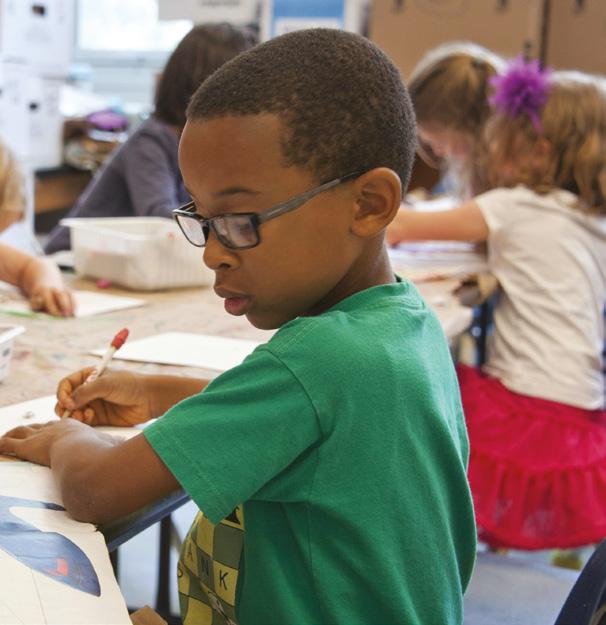


Many schools use class provision maps to keep track of children accessing additional support, such as a booster phonics class or social skills group. This provision map can be made available to parents as a record of any additional support being received. If parents feel that the school could be doing more for their child, they should ask for an appointment with the classroom teacher, as well as the school SENCO, to look carefully at the provision map/ personalised plan and see whether further support can be offered. Parents can also reference the school’s SEN Information Report to ask for specific interventions or different provisions.
If your child has a formal diagnosis or has been assessed by a specialist teacher, recommendations for support will have been included as part of the assessment. This should form the majority of the provision within the mainstream school offer, unless specialist support has been recommended. If this is the case, then the SENCO can ask for the Local Authority to fund this.
There are numerous local and national charities established to support families with children with SEN. These charities often have links to resources, recommended support groups, training and advice lines. The websites contain a wealth of information on specific needs (such as ADHD, ASD, Dyslexia, HI, VI etc) and are invaluable to families who are struggling to understand their child’s specific needs.

Local parent SEN groups can be used to ask questions and gain information about your local offer, as well as build relationships with other families who are experiencing similar difficulties and want to know more about how to help their child.
The Local Authority should also have links on their website to free and impartial advice for families with children with special educational needs such as IASK (Information, Advice and Support Kent) or SEND advice Surrey. These advice pages will contain information specific to the area and Local Authority you are within and are often a great source of support for parents who are navigating through Educational, Health and Care assessments or those requesting specialist school placements, transport and funding. Volunteers meet with families to complete paperwork and can come along to review meetings, mediation and tribunals.
4 Look for modifications that can be used to make your child’s (and your) life easier –
Too often, we find that there are simple changes that can be made to help children access their learning that the school is unable or reluctant to provide. For example, children diagnosed with Dyslexia, a specific literacy difficulty, can develop learning reluctance and poor mental health, and progress across the curriculum
can become stunted due to their literacy difficulties.
5Finally, but most importantly –keep a watchful eye over your child’s mental health and wellbeing
– Nothing will impact more on your child’s progress than low self-esteem and poor mental health. It is imperative that parents keep a watchful eye over their child’s mental health. If they feel that their SEN needs are impacting on this, make sure that the school is aware and is implementing strategies to support your child. There are lots of programs that schools can use to teach children about differences, resilience, self-regulation and neurodiversity. They can also provide safe spaces within the school environment that children can access when needed, as well as alternative play areas such as quiet rooms, nurture rooms or zoned playgrounds.
“Children with SEN are six times more likely to suffer from poor mental health”
The simple act of supplying assistive technology such as Orcam Learn (orcam.com/en-gb/orcam-learn) can have a dramatic effect on their access to all lessons, as well as building their self-esteem through complete reading independence.
Similarly, using assistive technology to support the recording of ideas rather than relying purely on pen and paper, can ensure that children are able to participate fully in a lesson and have their learning valued. Recording voice notes, using speech to text or taking photos to annotate are all easily accessible ways to increase a child’s record of work.
Simple environmental adaptations such as standing desks, wobble chairs, clear visual timetables, sensory circuits and outside learning classrooms can have a huge impact on how a child can access the main class activities. Sadly, many schools are unable to fund these adaptations and so parents are having to source the equipment themselves. Being a member of local charities can also help here, as they may have equipment loans, second-hand sales or grants that can be accessed for bigger purchases, such as a laptop or a specialist wobble stool.
Many schools have a Mental Health, Family Liaison Officer or Wellbeing lead, such as Alice Moore (hello@ alicekatharine.co.uk), who can offer advice and support to parents who are worried about their child’s wellbeing.
Children with SEN are six times more likely to suffer from poor mental health. Parents should ensure that they discuss their child’s mental health and wellbeing at the regular reviews with the school SENCO, making sure that it remains an area of focus, as well as an opportunity to ask for more specialist support if needed – such as play therapy, time to talk, counselling or family therapy.
Children can develop a variety of social, emotional and mental health difficulties as a result of their learning differences and, therefore, this should be given as much attention and resources as any academic provision.
Michelle Hinkley is the Assistant Headteacher for Inclusion, Specialist Diagnostic Assessor and Special Educational Needs consultant at Inclusive Education Services. If you would like more information or advice then please visit inclusiveeducation-services.com and contact Michelle directly who can provide support, training, diagnostic assessments and advocacy if required.
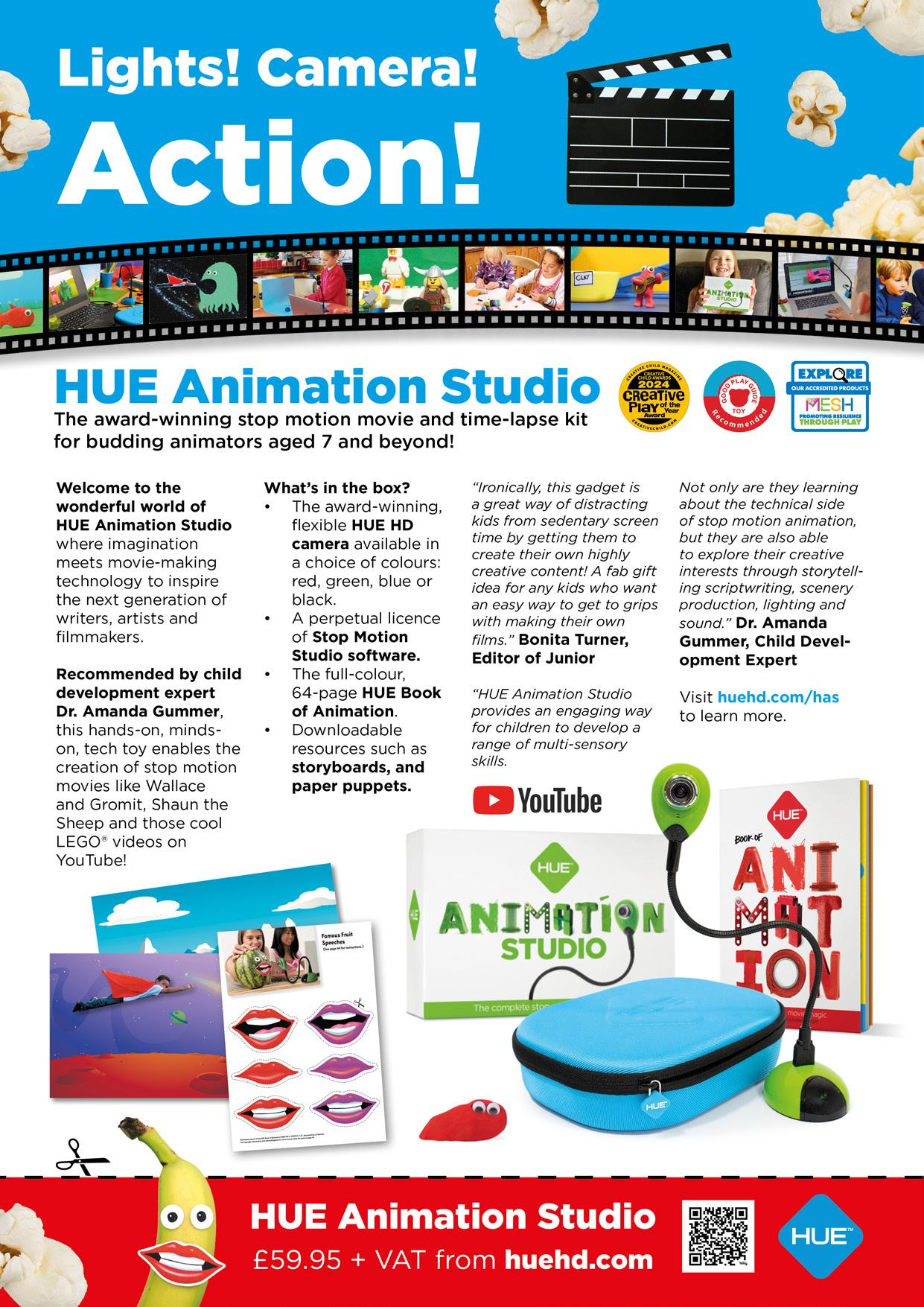
With Christmas on the horizon, Mumsnet tackles parents’ queries on budgeting, dealing with family gatherings and managing children’s expectations.
It has been a tight year for us financially and I’m already worrying about Christmas spending. What’s the best way to keep costs down?
QMumsnet users are super-savvy about Christmas spending, and their top tip is to set a budget – and stick to it. Do your sums and work out what you have to spend in advance before December comes around. Decide on price limits, shop around and don’t be afraid to suggest a Secret Santa to friends and family; they might find it a blessed relief. You should also keep your eyes peeled for discounts. There are hundreds of them around at this time of year as retailers compete for your custom and voucher codes and flash sale sites can be a lifesaver at Christmas.
When it comes to decorations, remember they don’t have to cost a fortune. Homemade snowflakes and paper-chains cost pennies and look lovely (as well as keeping your children occupied for, oh, minutes at a time, and furnishing you with a warm retro glow).
QWe’re
hosting the whole family for Christmas,
and I’m stressed out already at
the thought.
How can I
make sure it goes as smoothly as possible?
Firstly, plan ahead! Sort out everything you need to do before the big day and break it down into manageable chunks; that way you won’t suddenly realise you’ve forgotten something crucial at 11pm on Christmas Eve when all the shops are shut. That goes for cooking Christmas dinner as well – work out the timings ahead of the big day or you risk sitting down to turkey at midnight.
If you’re hosting the whole extended family, make sure you share the load. It’s perfectly acceptable to ask them to lend a hand or bring something. Lots
“When your children are grown up, it’s not the stuff that costs money that they’ll think of”
If you’re really stuck buying gifts, then use your skills. As well as being more personal, homemade gifts can save you cash. If you’re not craft-y, ‘vouchers’ for babysitting, decorating help or gardening will likely be a lot more welcome than socks. And finally, remember – when your children are grown up, it’s not the stuff that costs money that they’ll think of.
A visit to Santa’s grotto or a trip out to pick the Christmas tree are both magical; keep an eye open for local community events that are often a fraction of the price of those in stores.

of people divvy up different courses: one family brings a starter, one a dessert and one the cheese. Or, if you’d prefer to take responsibility for the food yourself, allocate some non-food-related tasks, such as crackers for the table or games for the kids. And remember to rope in the children – depending on their ages they can greet guests, lay the table and top up snacks and drinks.
And finally, Christmas can be emotionally pressured at the best of times and hosting means an extra level of stress. So don’t sweat the small stuff, remember to do something nice for yourself. And if your family is driving you nuts, remember that most people feel that way at some point over the festive season. Failing all that: gin.
QMy
child is at
an age where they’re just starting to understand the magic of Christmas and I really want to make it special for them, but I’m overwhelmed by
the traditions
that
are all over
social media. Elf
on


“Creating a magical festive season takes a lot of behind-thescenes graft”
the Shelf, North Pole Breakfasts, Christmas Eve Boxes…it makes me feel a bit inadequate! How can I live up to my children’s expectations for the festive season?

Every parent of young children wants them to have an amazing Christmas, but creating a magical festive season takes a lot of behind-the-scenes graft. For every Mumsnet member digging out the tinsel and ironing the family’s matching Christmas onesies in excited anticipation of the big day, there’s another who feels exhausted just by the thought of their Christmas to-do list. Insta snaps of others’ present mountains and picture-perfect family gatherings can certainly add to feelings of inadequacy and stress, but it’s worth bearing in mind that people only tend to share the stuff that casts their lives in the best light.
The great thing about family Christmas traditions is that you can create your own and swiftly lose anything that doesn’t work for you. Mumsnet users are pretty divided about Elf on the Shelf, for example. Some think it’s a way of gently encouraging good behaviour as the festive pressure ramps up, while others see him (or her) as a creepy

surveillance operative in striped leggings. If you think it’s something your kids would enjoy (and you don’t mind furiously racking your brains every night after bedtime for a new Elf escapade) then go for it, but if not then don’t put yourself under any pressure. As a general rule, Mumsnet users advise ditching anything that stresses you out or costs money that you can’t afford.

Mumsnet (mumsnet. com) is the UK’s biggest network for parents, with 9 million users per month and a mission to make parents’ lives easier.



“Rompa

“The



Catherine Oliver, author of new book
‘Working Parents-tobe’, explains that while going back to work after having children can feel very daunting, there are some simple steps you can take that can make a real difference.

Gnot alone in feeling daunted and wondering how you’re going to make it work. Nearly every parent I speak to expresses these types of concerns. So, what can you do? And where do you start?
1Start before you go – Yes, really. Work can feel like ‘tomorrow’s problem’, but some conversations are much easier to have before you start your leave. Exploring potential working arrangements, for example. You are almost guaranteed

oing back to work after having a child is tough. Even if you love your job, have the most supportive team going and part of you is really looking forward to getting back to work. Because it’s not just about you anymore. You can find yourself feeling guilty or worried about the choices you have made or are making. I’ve even heard someone say, ‘I feel guilty for not feeling guilty!’.
Then there’s the adjustment. You were an employee. Then you became a parent. Now you need to be both. And while it may not be your first child, there’s still an adjustment to being part of a growing family, for everyone.
“How will I still do my job in the same way?,” is another common fear I hear often. Sometimes it’s driven by a drop in confidence, sometimes it’s the looming logistics, often both.
Whatever the driver, the key point is you are
“Work can feel like ‘tomorrow’s problem’, but some conversations are much easier to have before you leave”
to need more flexibility when you go back to work – even if you’re full-time or it’s only informal. If you already have an idea of what that might look like, start sounding out colleagues. What’s worked for them? What hasn’t? And perhaps most importantly, why? It’s also worth considering opening a conversation with your manager before you go while there’s no pressure on either side and you both have time to digest the challenge and come up with ideas on how to make it work.
2
Keep in touch
while you’re on leave – How much, is up to you. There’s no right or wrong here, but focus on what is helpful to you. How connected do you want to be? It can be useful to think about it using a ‘what/ when/how’ framework, i.e. what do you want to stay in touch on (social only, big team/ business changes, projects?), when do you want to stay in touch on these (maybe not in the first three months, but in the three months before you return, or social throughout, but projects only as you are about to return), and how (via a friend on the team, your manager, via email or only when you go in on KIT days).
“You don’t have to get everything right on day one”
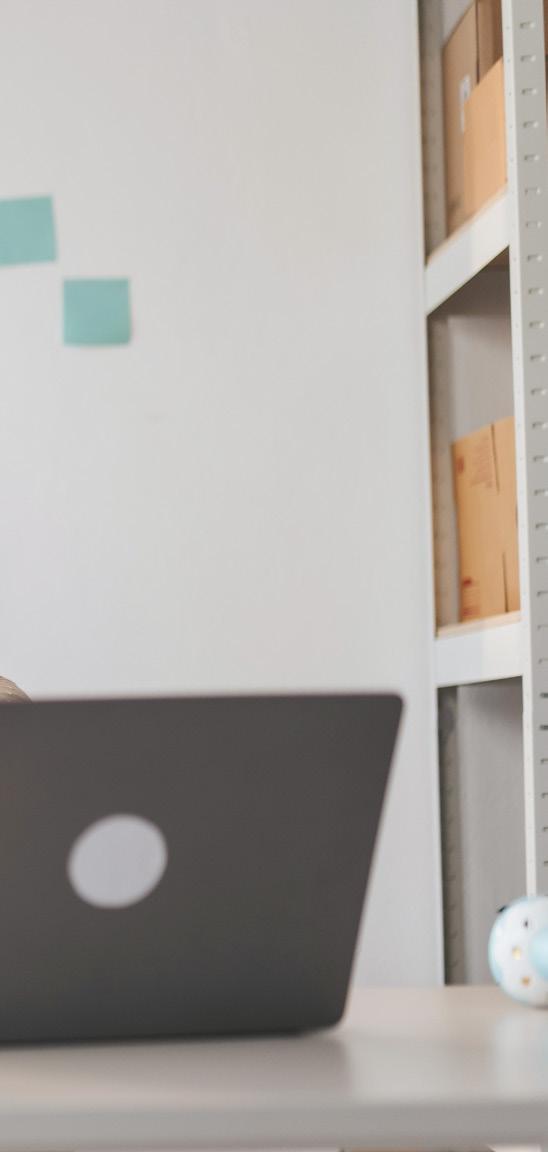


3 Create a return plan that’s right for you –
Your family, your role, your employer. If you want to change your working arrangement, start the conversations early and make them exactly that – talk first, paperwork later. And remember you have options when it comes to your actual return. If you think your employer might be open to it, consider using some of your KIT days and/or the annual leave you’ve accrued as a way of doing a few days a week before you go back to your full pattern (whatever that may be). It’s a great way to not only ease back into your role, but to also test out your childcare arrangements and get you and your family used to your ‘new normal’ more gradually, so when you’re properly back you have one less thing to worry about.
4 Start thinking about what you want your first day, your first week, your first month back to look like – My favourite question to ask people
here is, if you’d been back for three months and someone asked you how your return had gone and your answer was along the lines of “so much better than I feared, it went so well…”, why would that be? What needs to happen for you to get to a place where you feel like that? It will be unique to everyone, but for many of us it will involve feeling part of the team again, having met all the new faces, caught up with the old, clear on your priorities and those of your team, having adjusted to any new ways of working, and feeling you and your manager have established a way of dealing with the inevitable challenges etc. Consider what that would look like for you and then work out what that means for day one, week one, month one.
5 Do some practical preparation before you go back – Little things can also make a big difference. Is your tech set up? Do you know when the major events are happening you might want childcare for? Have you cleared your diary of personal appointments like the dentist or prescriptions, so that all you have to think about is your child and your job?

When you first go back it’s tempting to think you have to get everything right immediately, so that your new work/home arrangement will work all round. The reality is like anything new, it evolves and changes, and you need to evolve and adapt with it. You don’t have to get everything right on day one.
You will have bad days and bad weeks. Your childcare will break down at some point. You will undoubtedly be very tired. But you WILL get through it. We are so often our own worst enemies so be kind to yourself. And find a little me time each week to bring you joy – it will make you a better parent and a better employee.
8
Especially from others in the same boat. If your organisation has a parent or family network and/or offers transition sessions, sign up. If they don’t there’ll always be others like you, even if not in the same team/ department. And whether it’s a regular coffee with someone who’s ‘been there done that’, or a chat between meetings
with a colleague who’s also recently come back and ‘gets it’, finding those you can share moments with or even just a knowing look can make all the difference.
Catherine Oliver is a diversity and inclusion advisor who specialises in supporting working parents. Her new book ‘Working Parents-to-be’, is a step-by-step guide to parental leave and return. It’s available now from Amazon and all good bookstores. (amazon.co.uk/WorkingParents-be-parental-return/ dp/1788605993/)
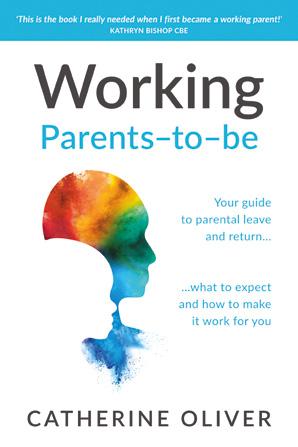

“We are so often our own worst enemies so be kind to yourself. And find a little me time each week to bring you joy”
Our
pick of some of
the best autumn reads reviewed by some of the toughest ‘tiny’ critics…
By Molly Potter,
illustrated by Sarah Jennings Age 4+ | RRP £6.99 | Available from Bloomsbury ( bloomsbury.com)

I liked this book because I thought boys couldn’t cry, but actually they can, everyone can cry, even me! I liked looking at all the things that can make you feel happy. If you’re feeling upset you should tell a grown up because they can help you or you can tell a friend, or if you are feeling cross you can just help yourself by doing lots of breaths. I liked learning some new words, now I know ‘frustrated’ and ‘overwhelmed’. The ‘park full of feelings’ was really good because it reminded me of school and I could talk about my friends. The pictures are really good because I know how
they’re feeling because of their eyes. If I feel mad now, I can just look at this book to help me.
By Rhiannon
Fielding and Chris Chatterton Age 2+ | RRP £7.99 | Available from Penguin Books (penguin.co.uk)

This one is about a tiny little wolf that likes to run away. I like his big eyes and bushy tail. I don’t think he likes to go to bed because he just wants to play with his friends. I liked already knowing the Fairy Tale characters like Little Red Riding Hood and I also liked it when they made Granny’s house look like Rapunzel’s house in the pictures. I really liked it when the Wolf got a fright when Little Red Riding Hood’s big round eyes did a blink because that made me jump!
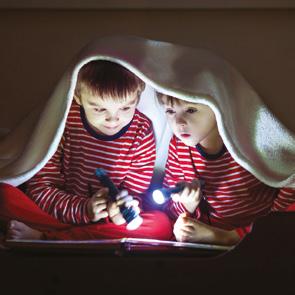


I liked it when the wolf carried Little Red Riding Hood’s basket in his mouth because that’s funny! My favourite part was when the Daddy said, ‘Two minutes to bed Little Wolf’.
By Rory Stamp, illustrated by Hannah Lawson

Age 4-8 | RRP £20 | Available (Shop.rnli.org/SummerRescue) £5.00 off for Family First Readers with discount code FFMAG-SOFF


I liked the story being on the beach especially when the waves got bigger and bigger and bigger because that was really scary! I liked it when the little girl was playing with her lifeboat and it fell - it made me scream! I really liked it when the lifeguard came in and saved the reindeer because that was very kind. I liked it when Rudolph said ‘Help, help me!’ because that is actually really important for you to say because if you don’t say that then they won’t be able to help you, but if you do say that then people will be able to hear you and then they can help you. I liked Rudolph being in the story. I liked the ending when they dried him and he walked away waving and he said, ‘If Santa was here with me, he’d give you a present from his sleigh!’. I felt really happy when the lifeguard saved the little girl’s boat!
By Andrew Jennings
Age 7+ | RRP £4.99 | Available from Bloomsbury bloomsbury.com)

I think this book is really good because it’s important to learn how to read because then when you grow up, no one needs to teach you, you’ll just be able to do it! You’ll get better and better and better if you practise and then you will be proud of yourself. I like how there are lots of different activities, so if you get bored you can just do the next one because there are lots of different pages. The Ninja hiding on each page is really good because he gives you a challenge or tip to help you and he can do the splits! I think you should do a bit of this book every day because then you will know all the words. You can do it with any grown up you want to, even your Nanny! I think the cover is really cool, it’s a bit like karate and I love karate – hi-yah!

Seren started Reception in September. She loves reading books about unicorns, magic and big bears. She enjoys her bedtime stories with a cup of warm milk. Seren enjoys having a story before she goes to sleep because she says it gives her sweet dreams.

Romina Bertinazzo, author
of Yummy Little Belly, shares some quick, easy and nutritious recipes that your little ones will love to try.
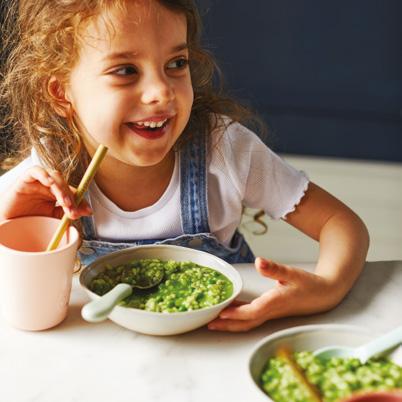
Weaning can feel like a big hurdle; parents want to do their best to feed their little ones a variety of nutritious food, without spending hours in the kitchen or endlessly sweeping meals up off the kitchen floor. I created the Yummy Little Belly cookbook, which is packed full of easy, colourful, tasty and healthy meal ideas for babies and toddlers from six months plus.
My mission is to bring harmony to mealtimes for the whole family with simple, tasty, wellbalanced recipes. I’ve shared a small selection of recipes from my book, including fruity pancakes and nutrient-rich pasta and risotto, to delicious healthy bakes.

Waffles make a wonderful snack or breakfast for little ones. Their shape makes them easy to cut into fingers, which is ideal for baby-led weaning. I serve them with plain yoghurt, fruit and a touch of maple syrup for a fancy breakfast, or simply plain as a snack or lunchbox filler. Don’t have a waffle maker? No problema! You can use this batter to make pancakes instead!
PREP: 5 mins | COOK: 10 mins
AGE: from 6 months | No dairy | Vegetarian
INGREDIENTS
- 1 small ripe banana
- 1 small egg
- 40g (11/2oz/generous 1/3 cup) porridge oats
- virgin coconut oil or unsalted butter, for greasing and frying
METHOD
1
2
Preheat a waffle maker and lightly grease it.
Put the banana, egg and oats into a food processor and pulse until it forms a smooth batter.
3 Spoon the batter into the waffle maker.
4
5
Cook the waffles according to your waffle maker’s instructions until golden.
Let the waffles cool slightly before serving.
STORAGE
Store the cooled waffles in an airtight container in the fridge for up to 2 days, or freeze for up to 3 months. Reheat from chilled or frozen in the toaster until warmed through.
Be sure to preheat your waffle maker. If you don’t, the exterior of the waffle won’t crisp up properly.

Whenever I ask my daughter Grace what she wants to eat, her answer is always ‘the green risotto!’. This dish is packed with iron and all the nutrients your little one needs to keep growing strong.
PREP: 5 mins | COOK: 20 mins
AGE: from 6 months | No eggs | Vegetarian
- 2 tablespoons extra virgin olive oil
- 30g (1oz) onion, finely chopped
- 50g (13/4oz) spinach leaves
- 500ml (17fl oz/2 cups) water, plus extra as needed
- 160g (53/4oz/3/4 cup) arborio rice
- 1 low-salt vegetable stock cube
- 60g (2oz/1/3 cup) frozen peas
- 30g (1oz/1/3 cup) grated Parmesan cheese, plus extra to serve
- 10g (1/2oz) unsalted butter
1
This green risotto is so hearty and packed with veggies that it makes for a satisfying dinner on its own, but for an extra boost of nutrition, I usually serve it with a side of fresh fruit. For older children and adults, you can add 1 teaspoon salt if using an unsalted stock.
If cooled within 1 hour, the risotto can be stored in an airtight container in the fridge for up to 2 days, or frozen for up to 3 months. Defrost in the fridge overnight. Reheat over a medium heat until heated through.
Heat the oil in a saucepan over a medium heat, then add the onion and sauté for 5–7 minutes until softened.
2 Meanwhile, put spinach and water into a food processor and blend until smooth, then add to the pan.
3
4
5
6
Add the rice and stock cube, bring to the boil, reduce the heat to low-medium and cook for 10 minutes, stirring every few minutes to prevent sticking.
Add the peas and cook for a further 7 minutes, adding a bit more water if needed.
Once the rice is cooked and the risotto is thick and creamy, remove from the heat. Stir in the grated Parmesan and the butter and allow to rest for 1–2 minutes.
Serve with an extra sprinkle of grated Parmesan, if desired.
Note: for babies under 1 year old, flatten the peas before serving









I’m always looking for tasty ways to sneak in healthy fats and veggies that my kids will actually enjoy. Avocados are a nutrient-dense option for babies and children – not just one of their five-a-day, they also contribute all-important heart-healthy fats and gut-loving fibre. Since my daughters love avocado, I thought, why not try it in a pasta sauce?
PREP: 5 mins | COOK: 10 mins
AGE: from 6 months | No eggs | Vegan option | Vegetarian
- 100g (31/2oz) pasta of your choice
- 1 ripe avocado, peeled and stoned
- 2 tablespoons ricotta cheese or dairy-free cream cheese
- 1 teaspoon extra virgin olive oil
- 1-2 tablespoons grated Parmesan cheese, plus extra to serve (optional)
METHOD
1
2
Bring a large saucepan of water to the boil and cook the pasta according to the packet instructions, then drain, reserving some of the pasta water.
Meanwhile, mash the avocado with the ricotta and olive oil in a bowl. Add the Parmesan, if using, and a few tablespoons of the pasta water. Mix until smooth. Adjust the consistency by adding more water if needed.
3
Add the pasta to the avocado sauce and mix well until the pasta is coated.
4 Serve with grated Parmesan on top, if desired.
This is best eaten fresh, but leftovers can be stored in the fridge for a few hours without much browning. To prevent browning, add a thin layer of olive oil on top.

These banana bread muffins are sweetened with bananas only, making them perfect for babies of any age! For best results and a naturally sweet flavour, choose fully ripe bananas for this recipe!
PREP: 10 mins | COOK: 20 mins
AGE: from 6 months
- 200g (7oz) overripe bananas
- 100g (31/2oz/3/4 cup) oat flour
- 15g (1/2oz) smooth peanut butter
- 2 teaspoons baking powder
- 30g (1fl oz/2 tablespoons) whole cow’s milk or plant-based milk alternative
- 30g (1oz) dark chocolate, chopped (optional)
METHOD
1
2
3
4

Preheat the oven to 180°C/160°C fan/350°F/gas 4 and line a six-hole muffin tin with muffin liners.
In a bowl, mash the bananas, then add the remaining ingredients and mix well.
Spoon the mixture into the muffin liners and bake for 18–20 minutes until golden and a skewer inserted into the centre comes out clean.
Remove from the oven and allow to cool before serving.
Note: don’t add the chocolate for children under 2 years old
Store in an airtight container for up to 3 days, or freeze for up to 3 months. Defrost in the fridge overnight. You can warm them up in a low oven before serving if desired.

Yummy Little Belly: Over 80 quick, easy and nutritious recipes to keep you and your little ones happy by Romina Bertinazzo is available now (£18.99, HarperNonFiction).
Romina, AKA @yummy_little_ belly, has 1.2m followers on Instagram and 284k on Facebook; based in London but from Italy, she is raising her two little girls on balanced meals using the wholefood ingredients she grew up with. Her most viral recipe reels receive upwards of 3m views.
Feeding your child can feel overwhelming with all the conflicting nutrition advice that is now available. This guide simplifies the essentials of balanced kids’ nutrition, helping you support your child’s growth and development with practical, everyday tips
By Lucy Upton, Specialist Paediatric Dietitian
You’re not alone if feeding your children feels overwhelming or you’re confused by the endless nutrition advice online. Many parents ask me, “What should I actually be feeding my child?” In fact, 55% of parents report feeling uncertain about what the best foods to give their children are (1). This confusion can begin as early as weaning, with at least half of parents are unsure when to start solids or how much to offer (2). Conflicting information, especially on social media, only adds to this uncertainty. So, let’s go back to basics and explore what balanced nutrition for a healthy childhood looks like!
lifelong healthy eating habits, and a child’s diet significantly impacts their growth and development more than at any other stage. By age three, your child will be about 50% taller than at birth, four times their birth weight, with a brain 80% of its adult size. The gut microbiome will also have reached an adult-like state. The fuel for this growth and development is milk in the early months, but for a significant portion of this time, the primary fuel will be food! As a parent, feeding your child can feel like a huge responsibility, so let’s simplify children’s nutrition for you throughout this rest article!
“Childhood, particularly the early years, is the prime time to focus on good nutrition”

Childhood, particularly the early years, is the prime time to focus on good nutrition. During this period, we help establish

When planning meals and snacks for children, I encourage parents to consider combining the food groups below. This helps to include a range of nutrientdense foods that children need.
1
Carbohydrates/starchy foods are one of your child’s primary energy sources, helping fuel their rapid growth and development. Carbohydrate foods also provide B vitamins, folate, and fibre. Options include rice (like Tilda Kids rice and vegetable pouches), potatoes, pasta, bread, noodles, and grains.
2
Fruits and vegetables are a crucial source of vitamins, minerals, and antioxidants that benefit a child’s overall health and immune function. It’s recommended that five portions of children’s size (smaller than adults) be offered daily; however, research shows that most young children don’t reach their 5-a-day (3). Helpfully, Tilda Kids rice and vegetable pouches contain one of their 5-a-day.
3
Protein-rich foods are vital for building and repairing tissues. They are also a key source of essential vitamins for babies and young children, such as iron and zinc. Options include meats, poultry, fish, eggs, beans, and legumes.
4
Dairy or dairy alternatives provide calcium, which is essential for developing strong bones and teeth, and other nutrients like iodine, which young children need plenty of for brain development. Options include full-fat dairy products like milk, cheese, and yoghurt and fortified milk alternatives such as soy, oat, or coconut-based drinks, yoghurt, and cheese alternatives. Many dairy products or alternatives can be weaved into your kids’ meals, such as milk into white sauce or cheese into pasta or rice (Like Tilda Kids Cheese & Tomato rice)


5
Healthy fats are essential for babies and young children to help meet their high energy requirements and support brain development. Fats should provide around 40% of a young child’s daily energy intake, so healthy fats found in oils, e.g., olive or rapeseed oil, avocados, oily fish, nuts, and seeds (avoid whole < 5 years) will support brain and physical growth.
Meals that hit this nutritional mark don’t have to be complicated or time-consuming. For example, balanced meals can include convenient ingredients such as cereals, oats, frozen fruit and vegetables, eggs, tinned beans and pulses, and Tilda Kids rice and vegetable pouches (ready in 40 seconds!).
Here are some quick and easy options that combine some of the food groups above to demonstrate the importance of building balanced meals for young children.
Porridge-made milk, with added grated apple and peanut butter = carbohydrate + dairy + fruit + healthy fat
Scrambled egg with toast and diced cherry tomatoes = protein and fats + carbohydrate + vegetable - well, a fruit!
Cheesy salmon and pea pilaf (scan recipe QR code below) combines a handful of ingredients with a convenient Tilda Kids Cheese & Tomato rice pouch ready in 40 seconds = protein and fat (salmon) + carbohydrate (rice) + vegetables (1 of 5 a day in rice pouch + peas, onion and spinach)




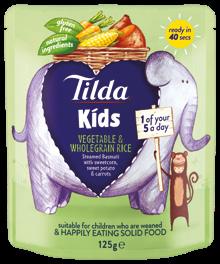
My final tip for balanced kid’s nutrition is to offer variety. Dietary diversity supports exposure to different tastes, textures, nutrients, and cuisines, which can significantly impact health. Some of my favourite ways to add variety to children’s diets include:


Combining these food groups at mealtimes ensures that your child’s meal or snack is nutritious and provides plenty of the necessary nutrients. Once a child is over one, it’s recommended that they aim for the following daily;
5 portions of carbohydrates
5 portions of fruit and vegetables
5 portions of dairy or alternatives
5 portions of protein
Jacket potato with low sugar and salt baked beans + cheese + one satsuma = carbohydrate + protein + dairy + fruit
Egg rainbow veggie rolls with tahini dipping sauce* (scan recipe QR code on the right) = protein (eggs and tahini) + carbohydrate (rice) + dairy (yoghurt) + vegetables (1 of 5 a day in rice pouch, carrot, pepper and spinach)
References
Choose fruits and vegetables in different colours, or swap them out every few weeks based on what’s in season (which also saves money!).
Introduce herbs, spices, and flavours to help build a broad palate while incorporating more plant-based foods (yes, herbs and spices count!). The Tilda Kids rice and vegetable range (which you can find down the baby and toddler aisle), for example, varieties like Tilda Kids Vegetable Paella rice, with four vegetables and fun flavours like smoked paprika, are great options for offering variety
Rotate grains like quinoa, barley, different types of rice, and buckwheat for unique textures, flavours, and nutrients.
Mix up protein sources such as beans, lentils, tofu, and different fish or poultry to keep meals exciting, varied and balanced.
1. https://www.nutrition.org.uk/news/chicken-and-cheese-in-your-5-a-day-british-nutrition-foundation-survey-reveals-widespreadconfusion-about-healthy-eating/ 2. https://www.gov.uk/government/news/campaign-to-help-parents-with-introducing-babies-tosolid-food#:~:text=The%20campaign%20comes%20as%20a,conflicting%20advice%20on%20both%20points. 3. https://www. gov.uk/government/publications/sacn-report-feeding-young-children-aged-1-to- 5-years *omit honey in this recipe for children < 1 year
















Lenovo IdeaPad Slim 3 MediaTek Chromebook 3288599

Acer CB314 Celeron Chromebook &Mouse Bundle 3636141 ASUS CX1500 Pentium


Lenovo IdeaPad Slim 3i i3 Chromebook & Case Bundle 5028159


HP 15a-na0007na Celeron Chromebook 4708119


ASUS CX34 i3 Chromebook Plus 3288458


ASUS E210 Celeron Cloudbook 3930823


Lenovo IdeaPad Flex 5i i5 2-in-1 Laptop 4849621


ASUS Zenbook 14 OLED i5 Laptop 4638382


HP 11-ak0027na Celeron Cloudbook 9626306


Samsung Galaxy Book4 i3 Laptop 4359575


HP Envy 17-cw0003na i5 Laptop 3412523










FHD




